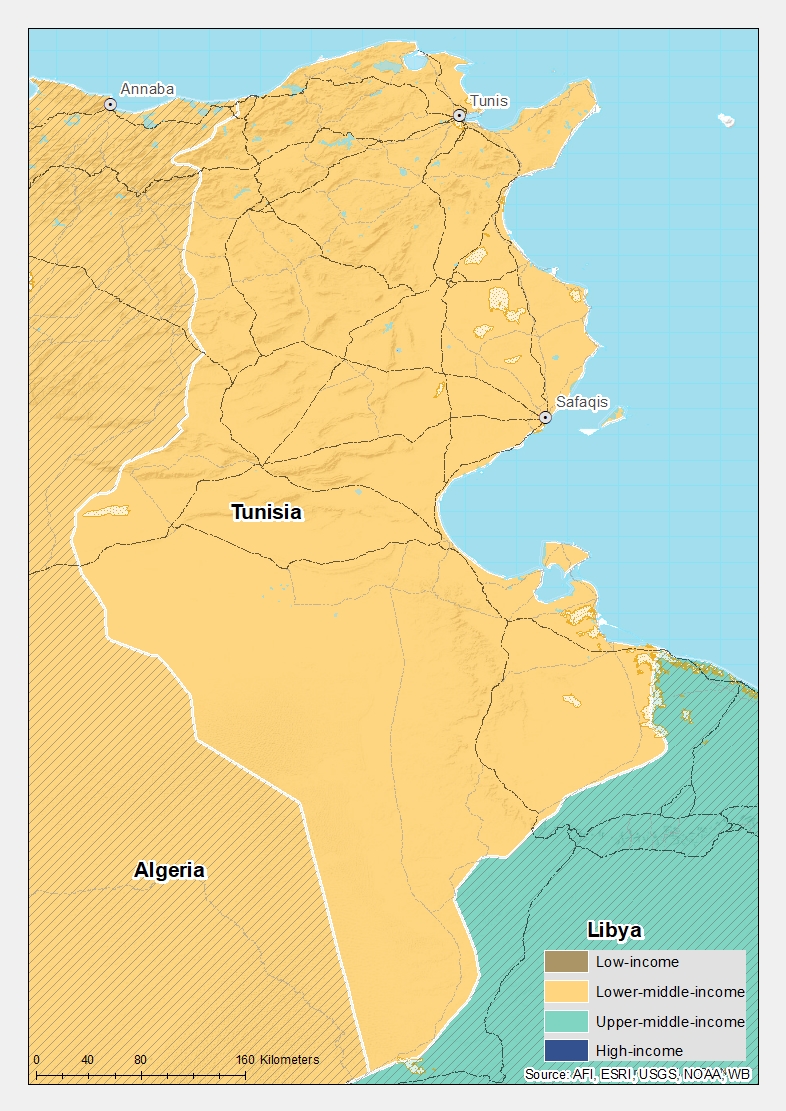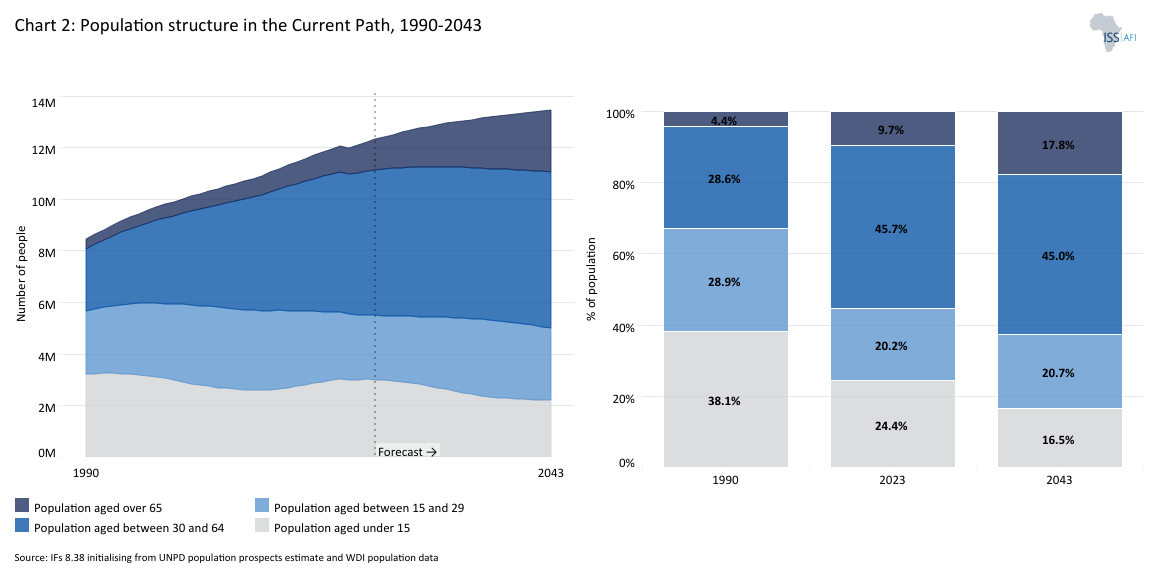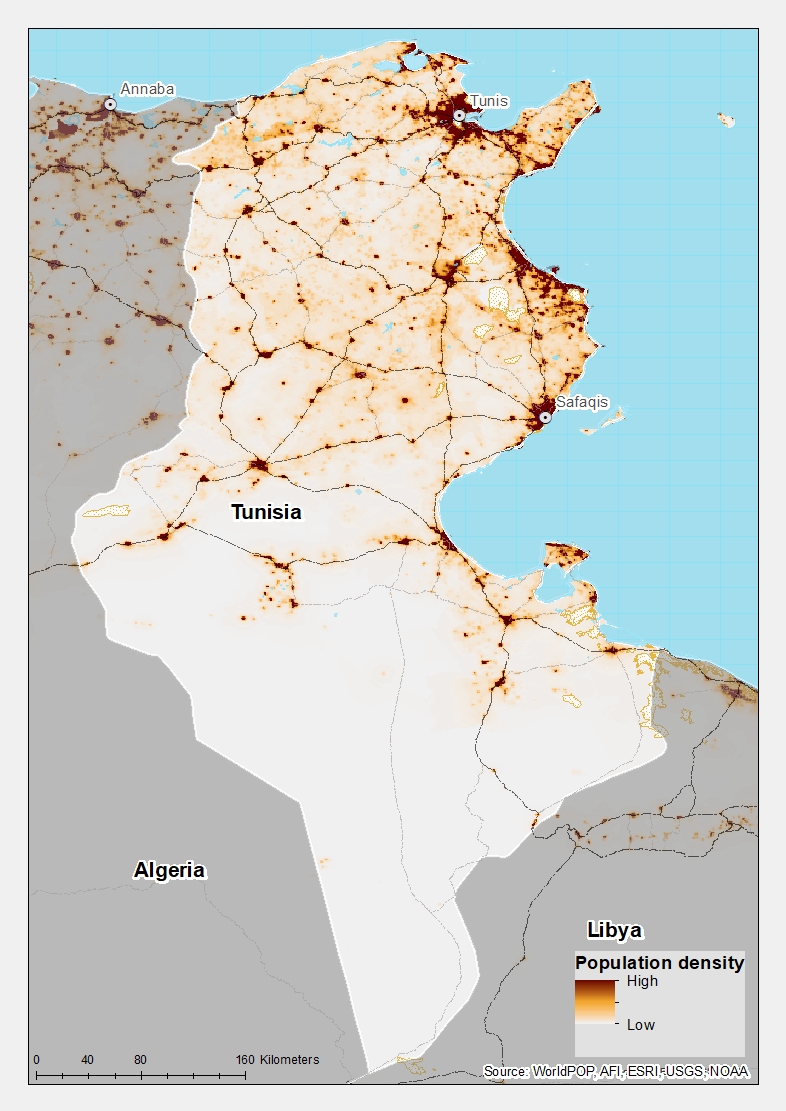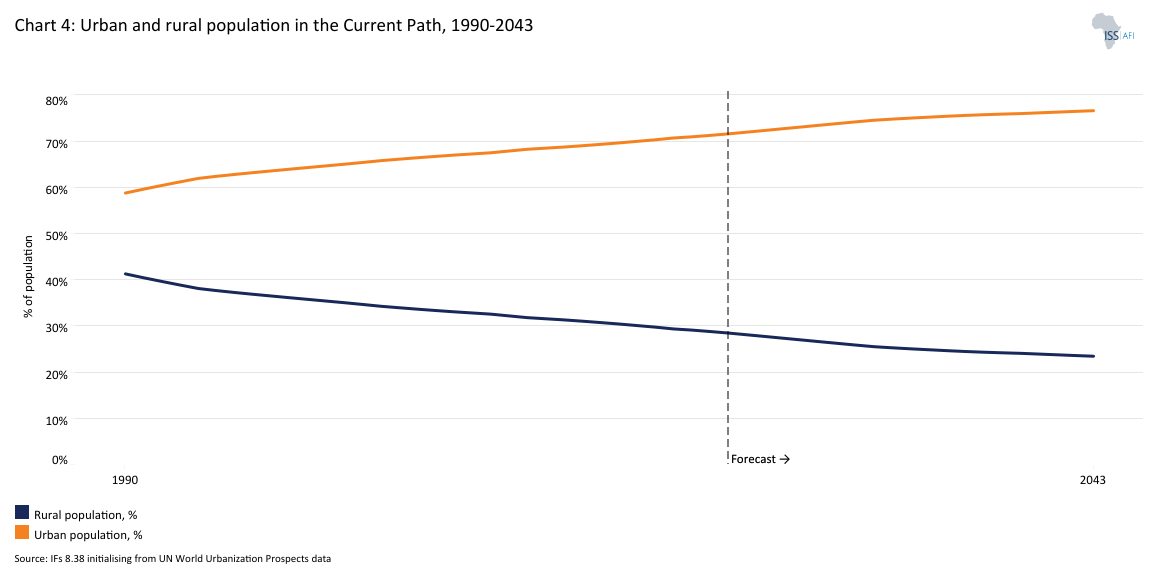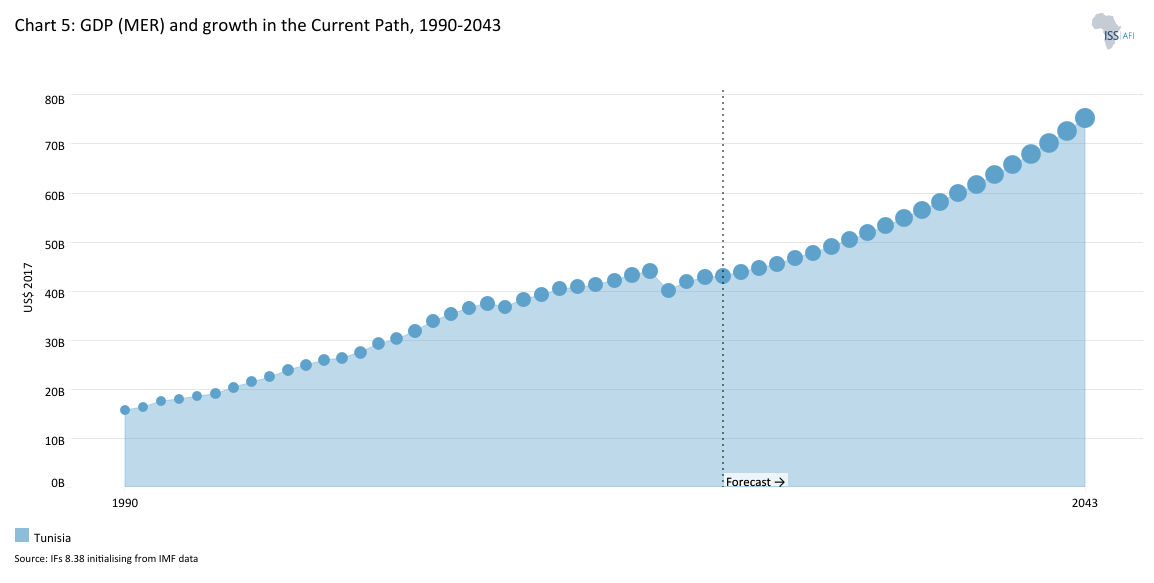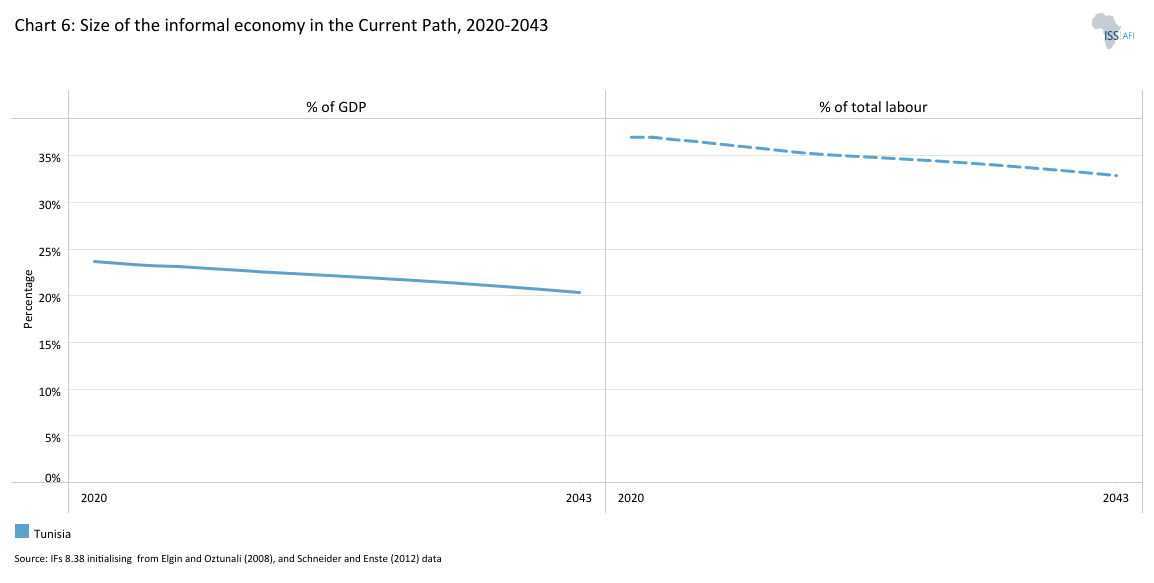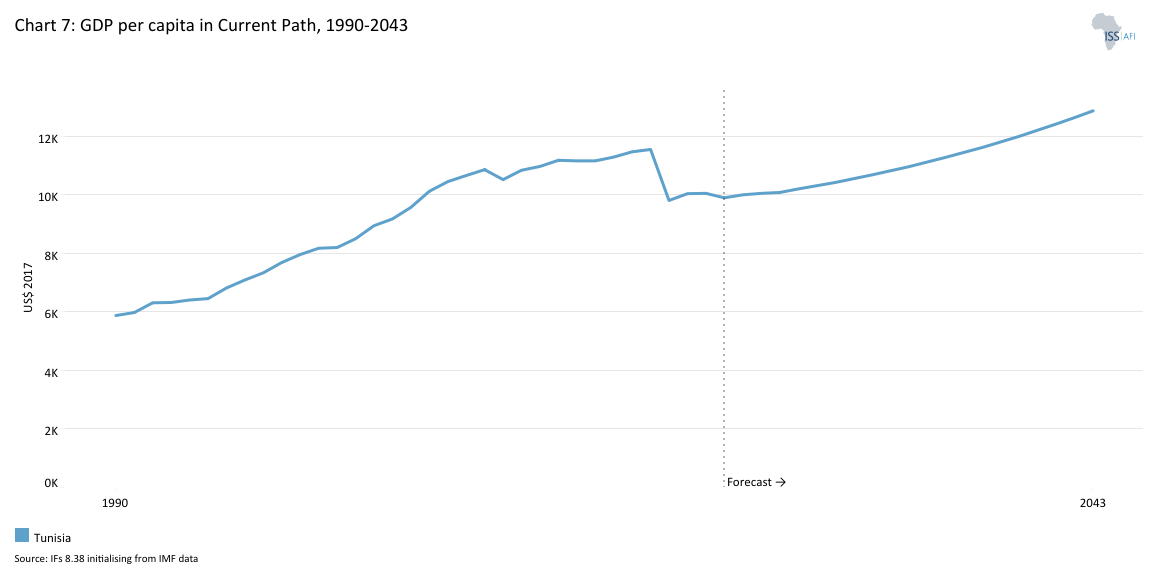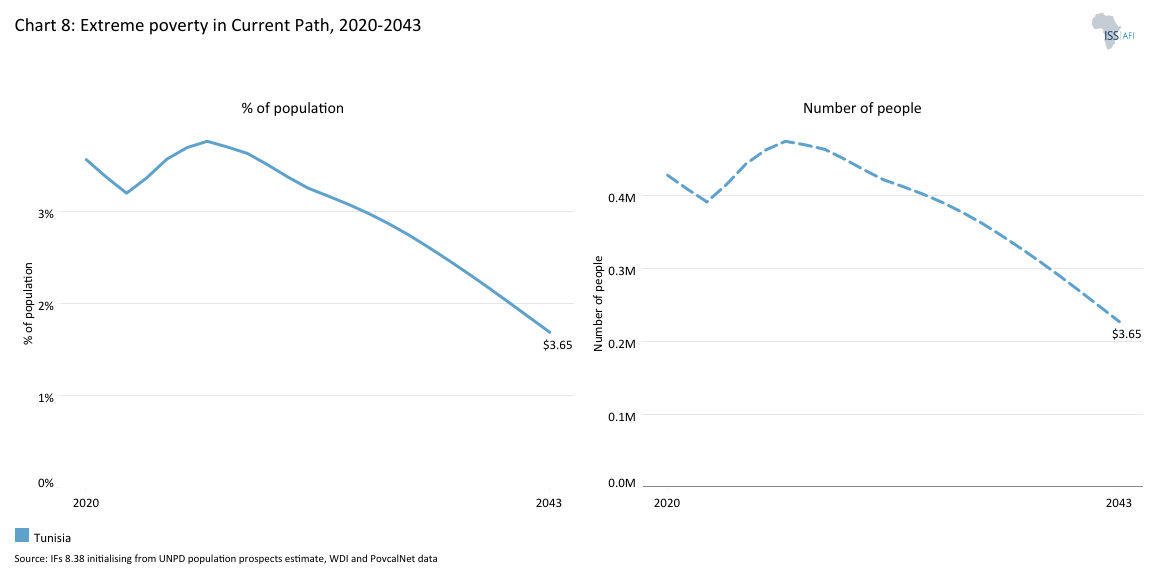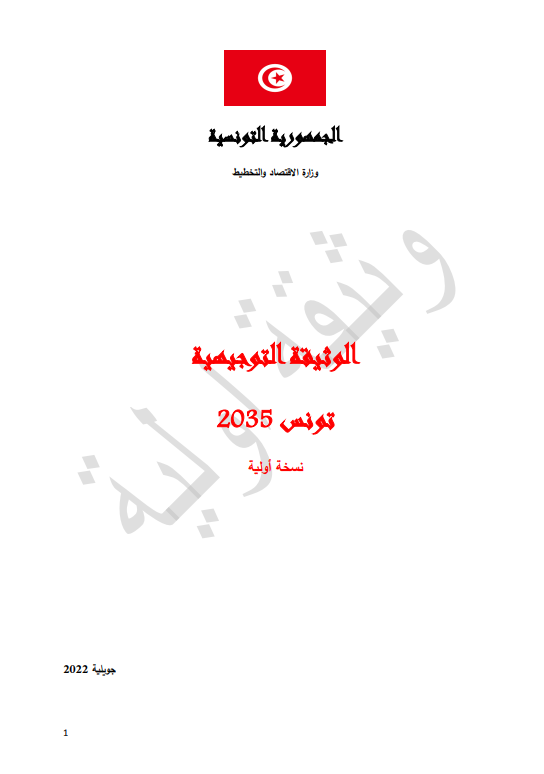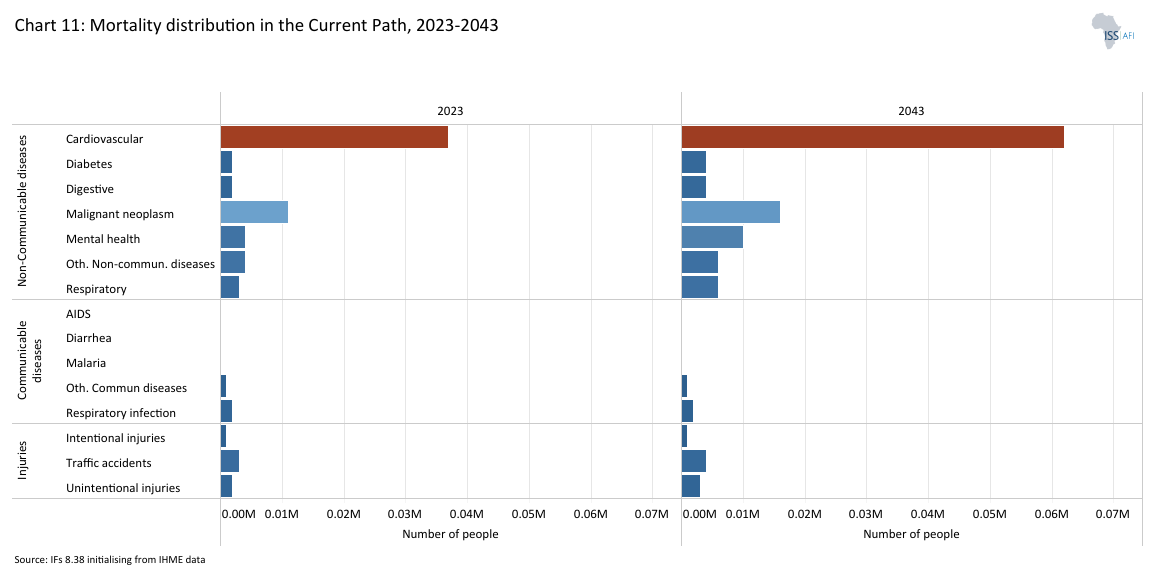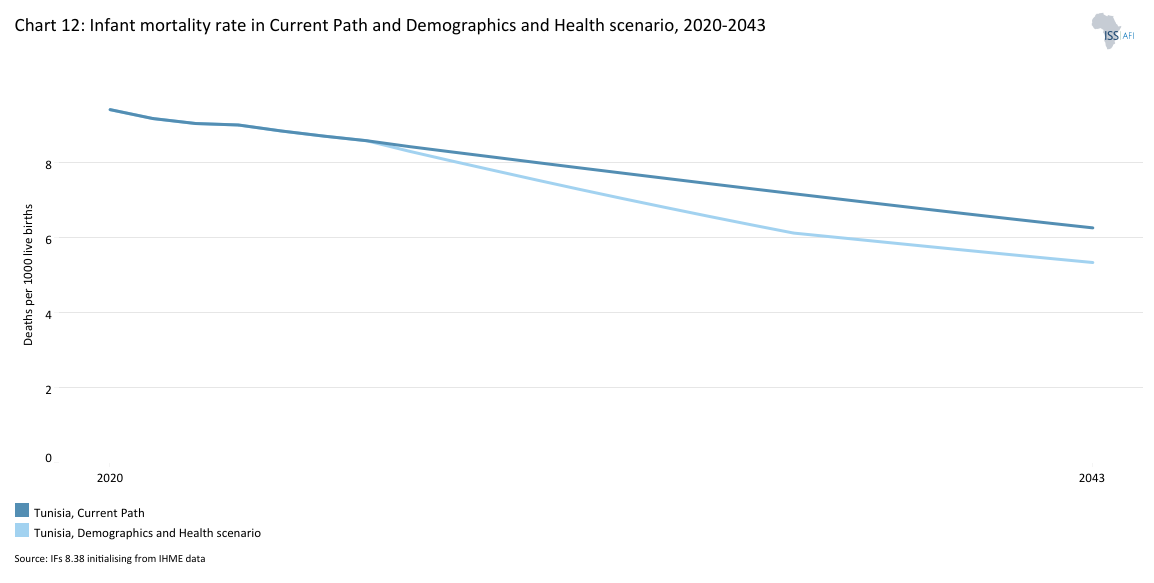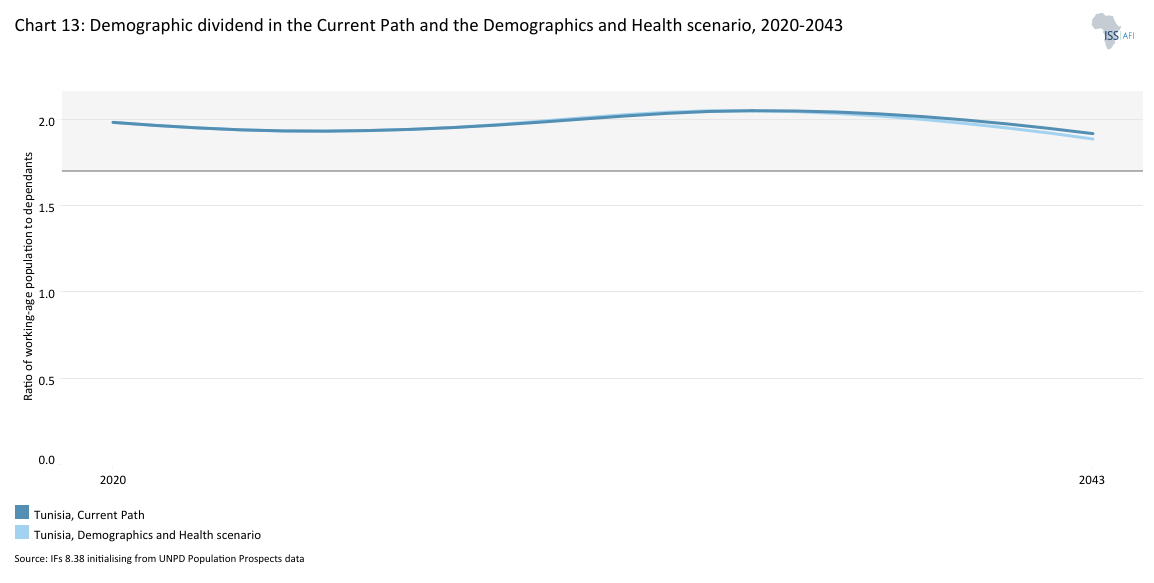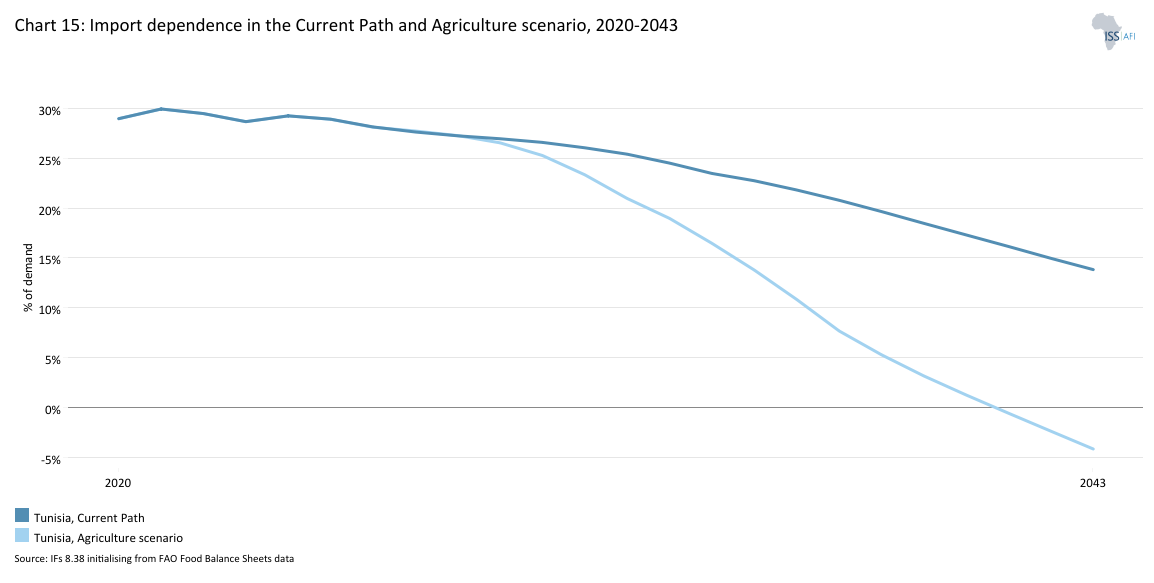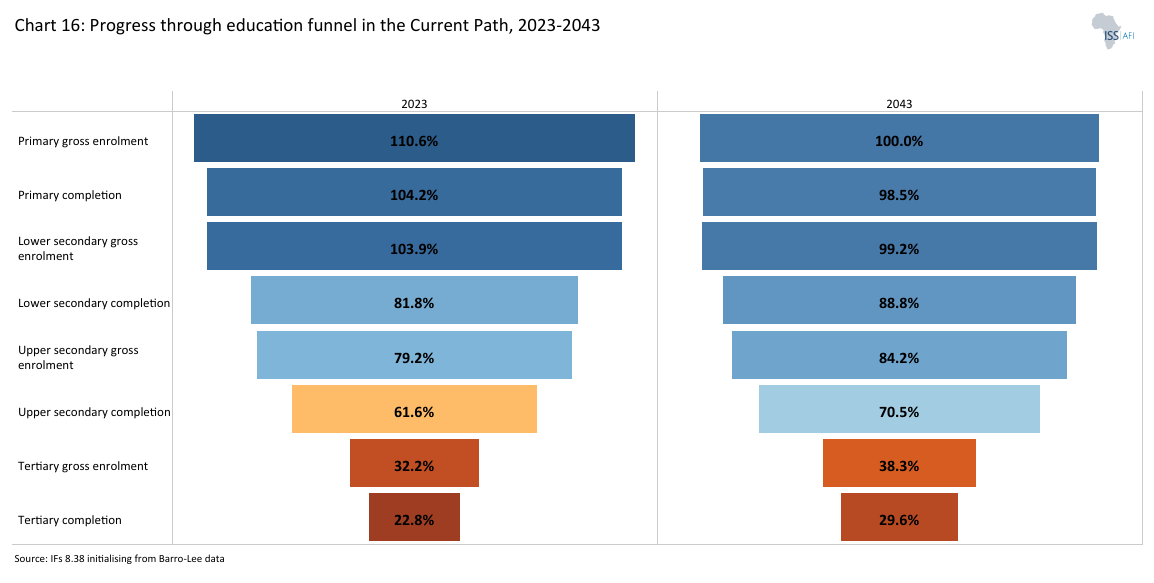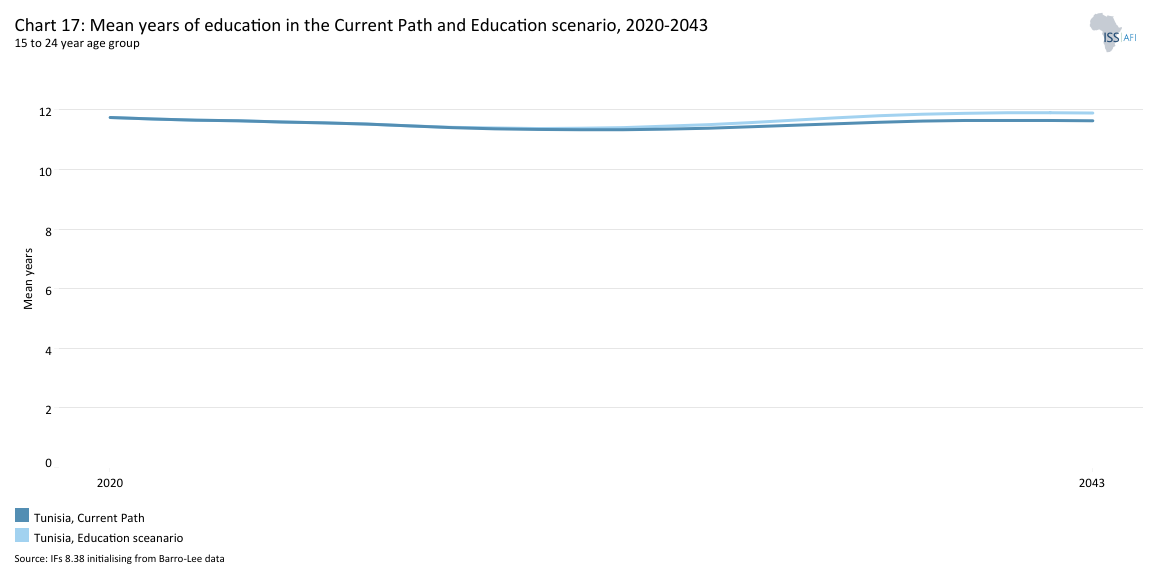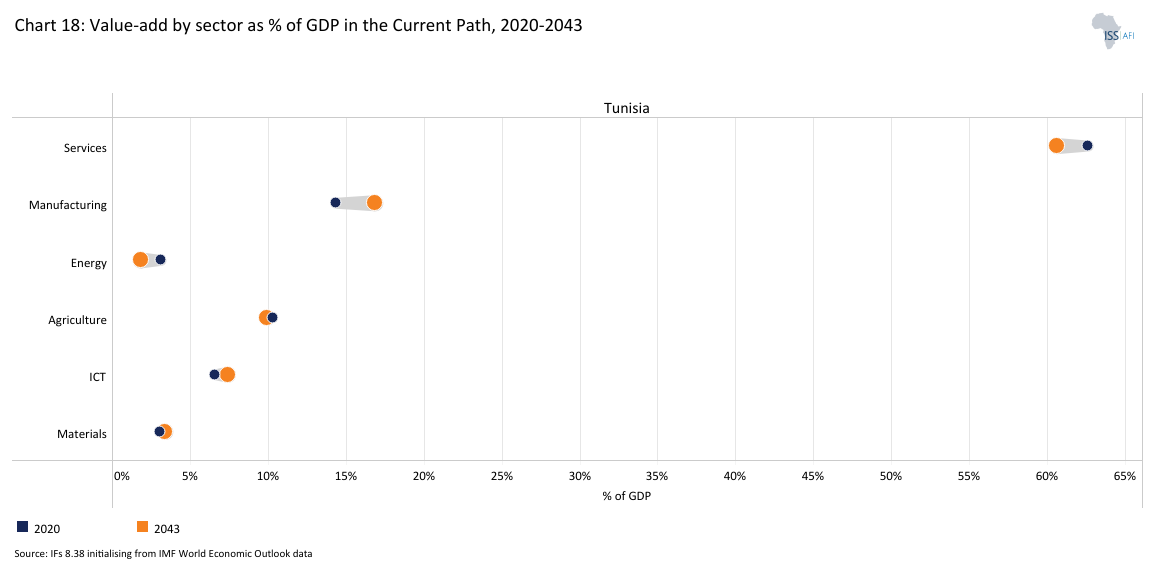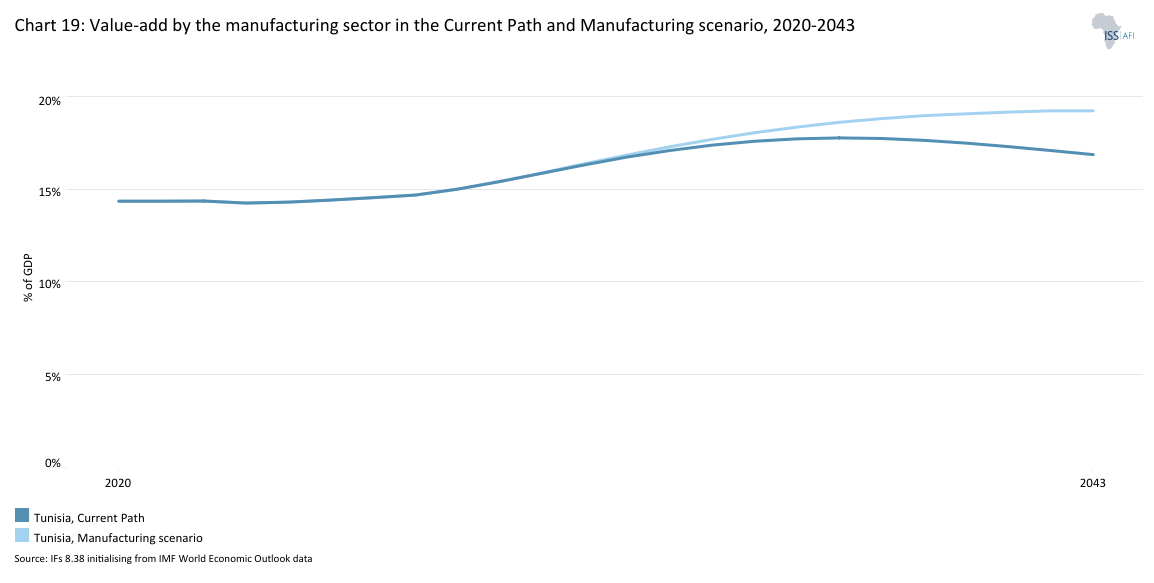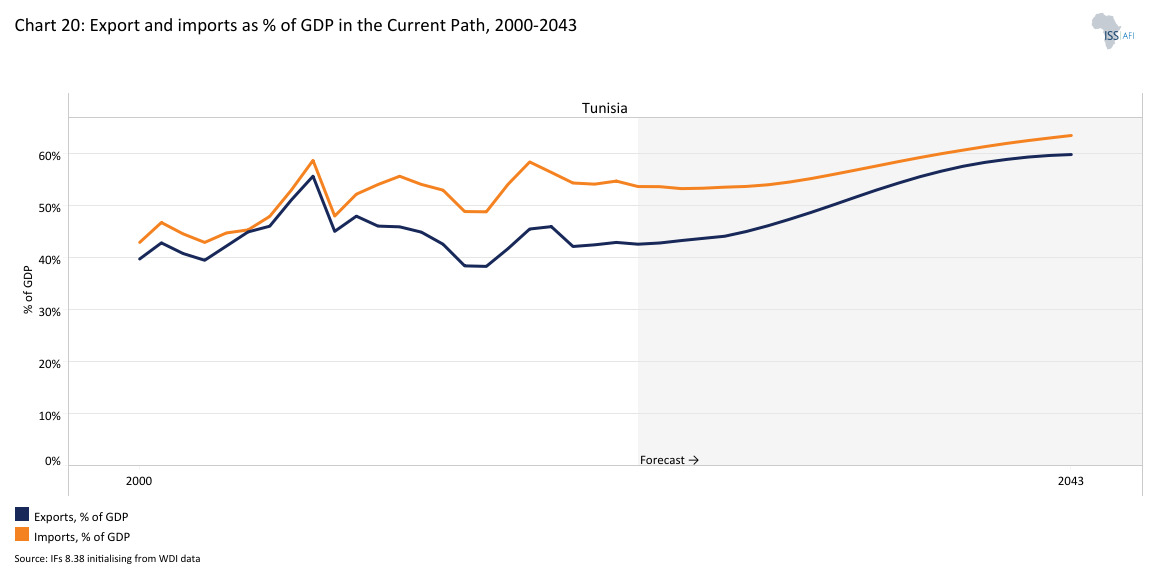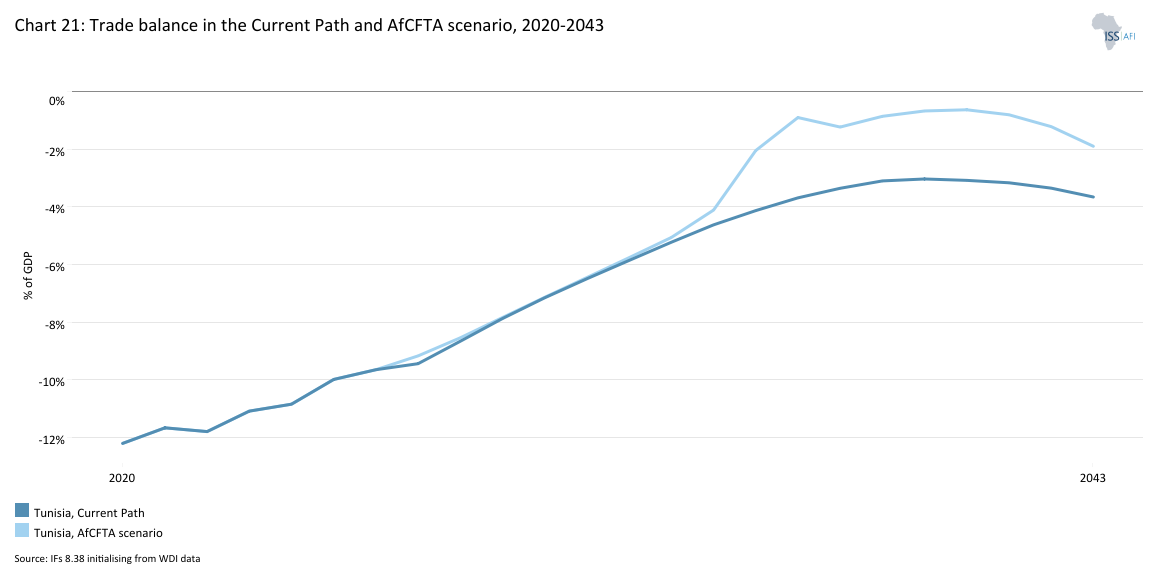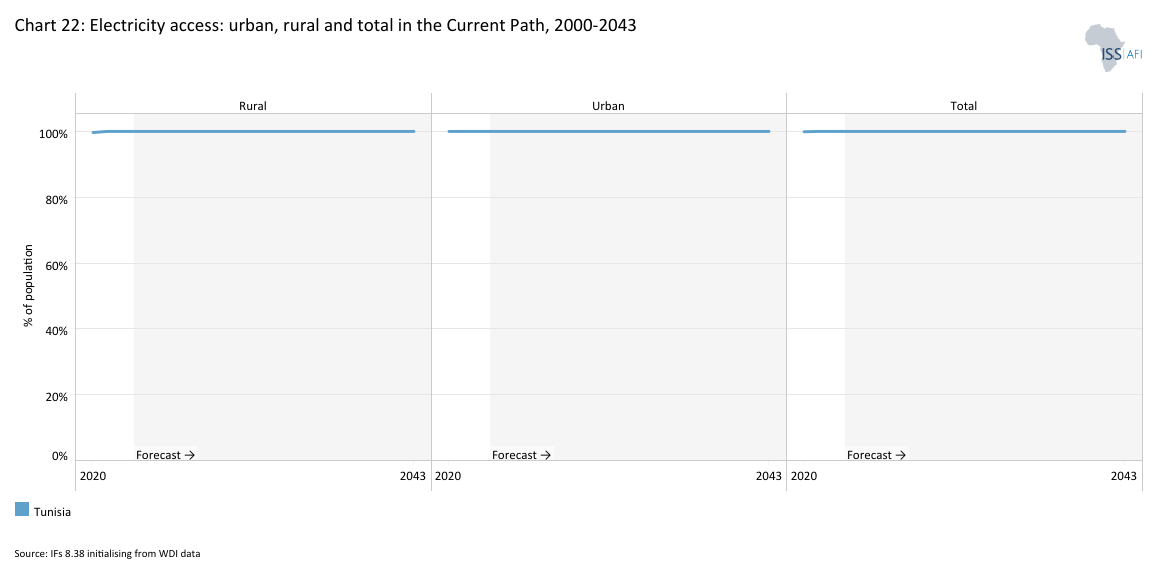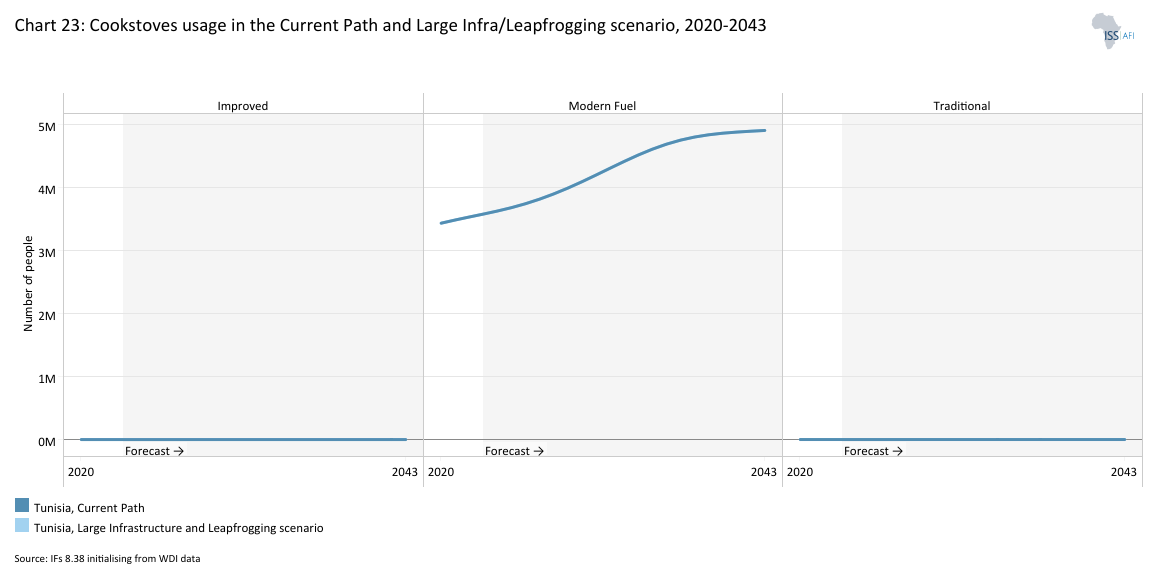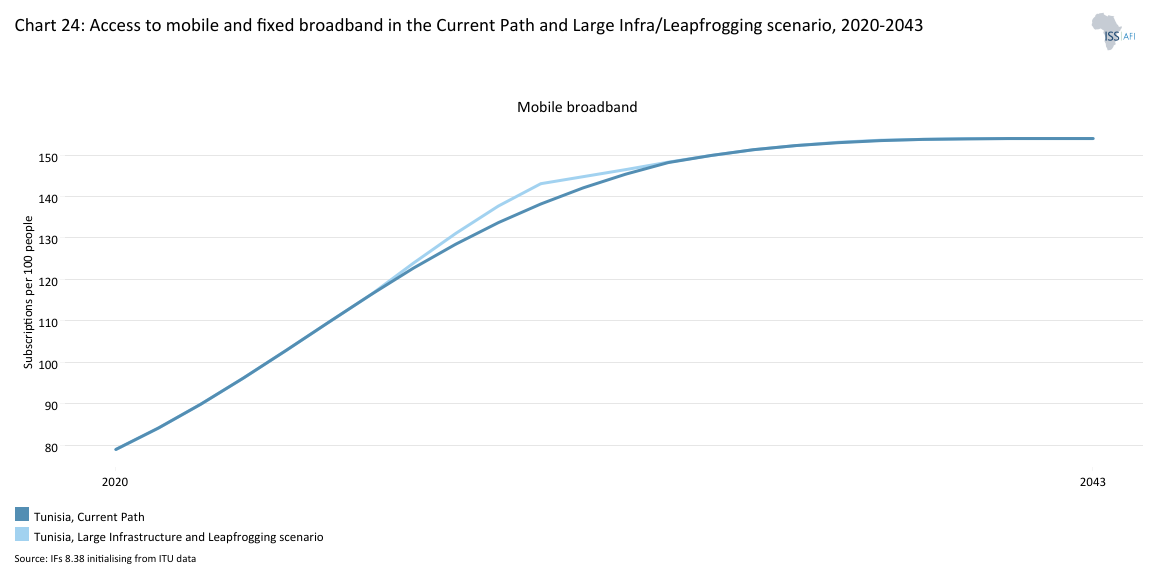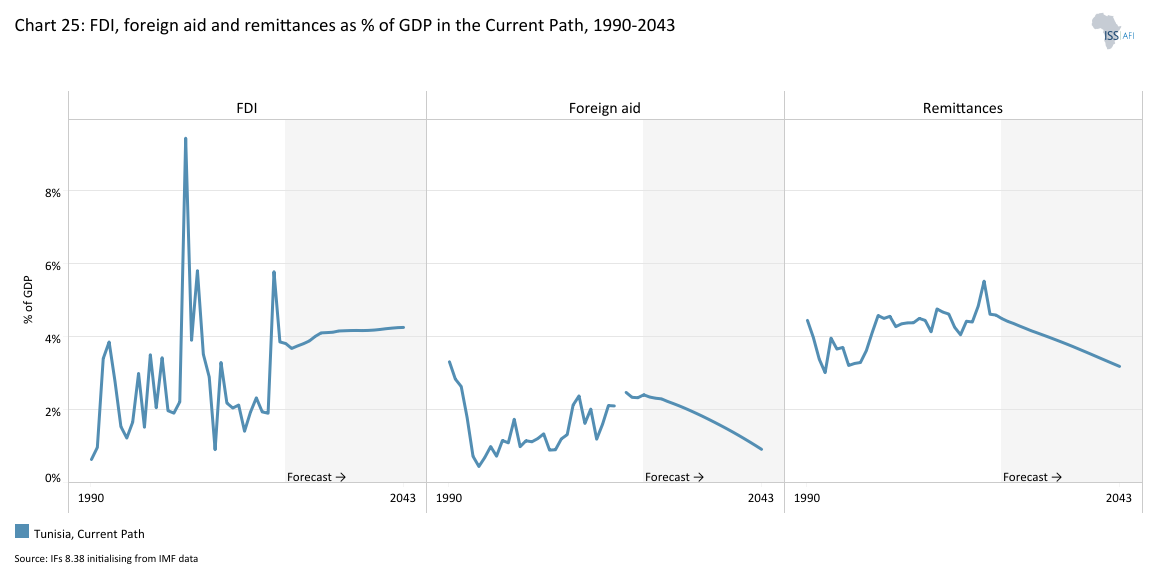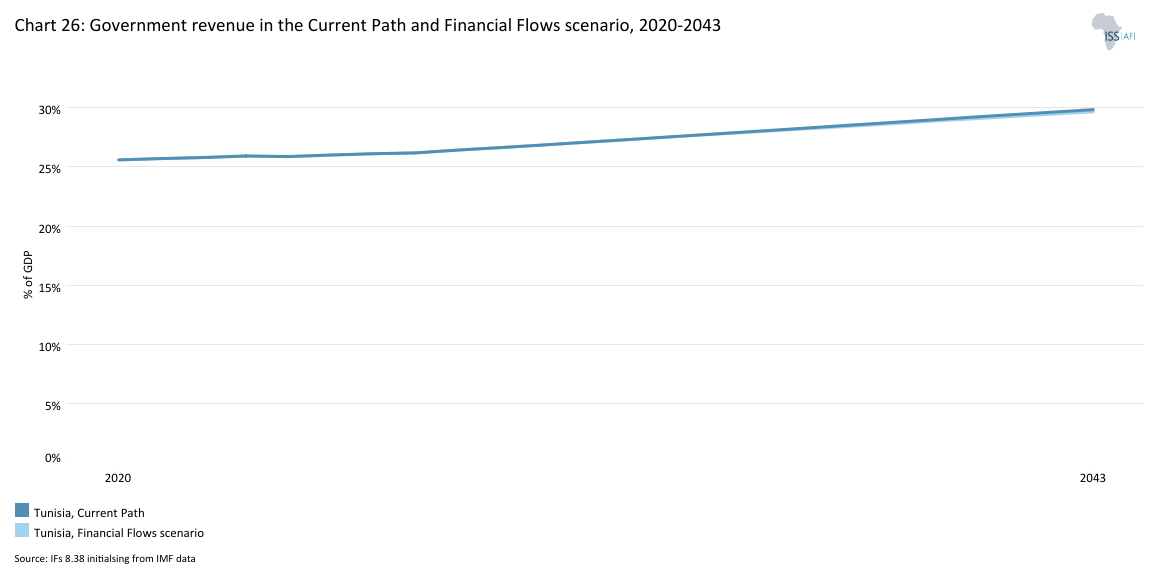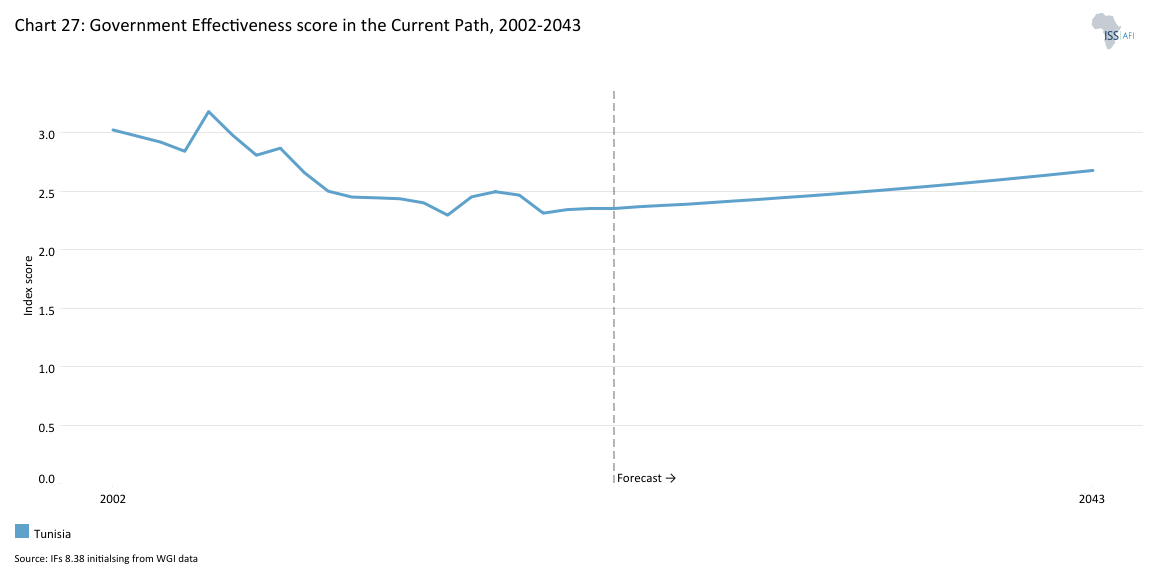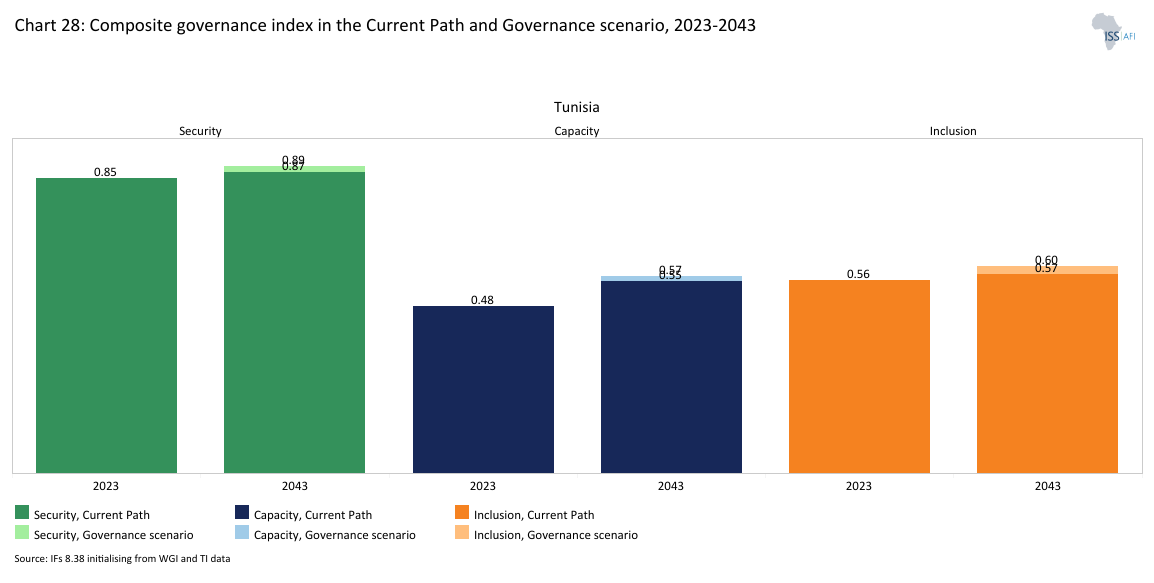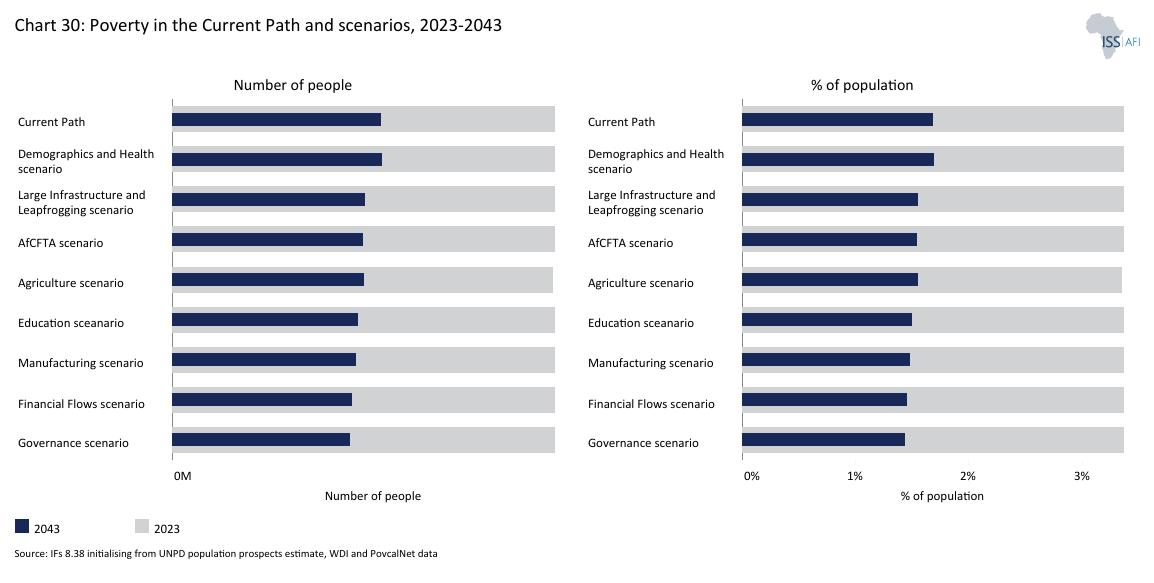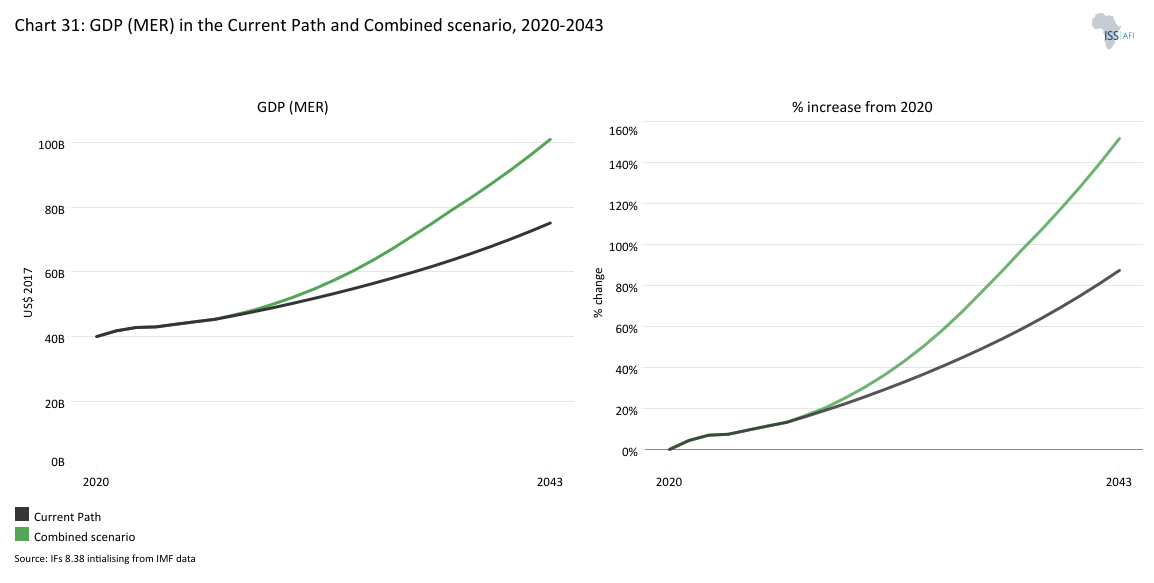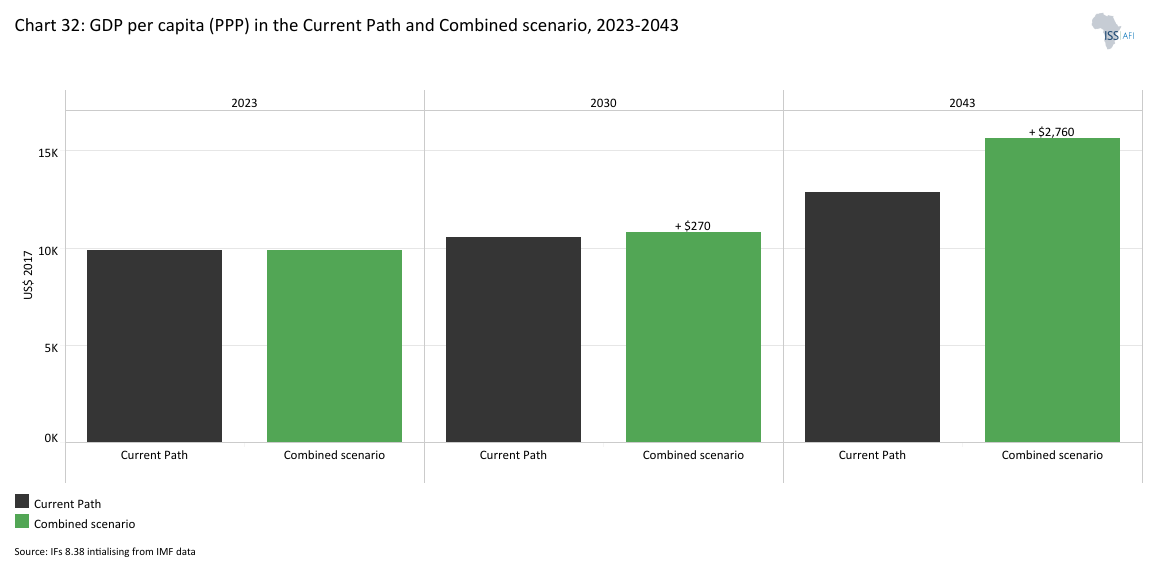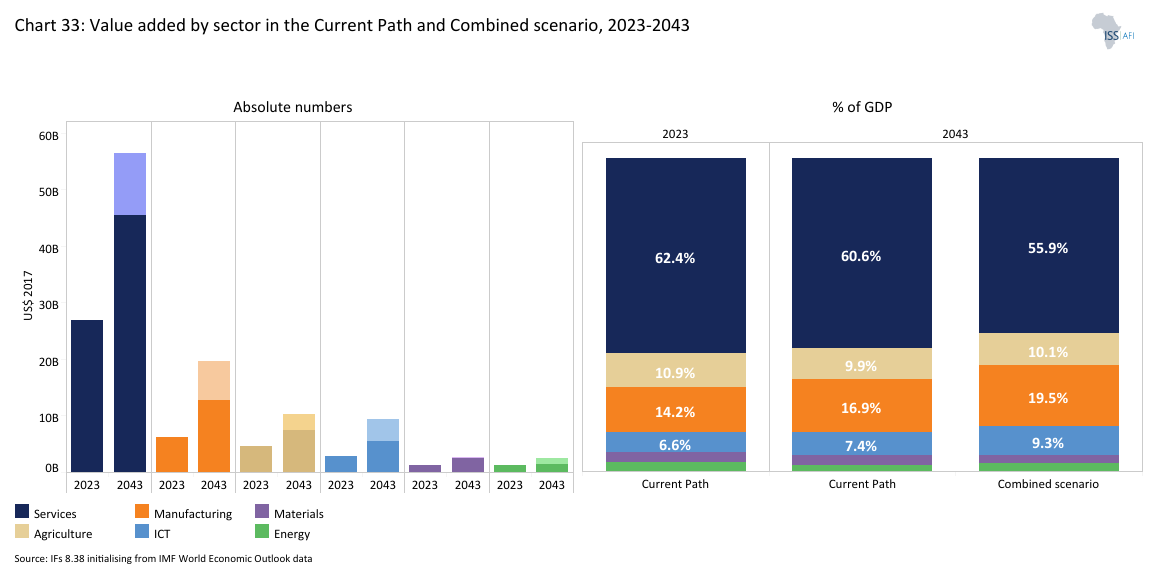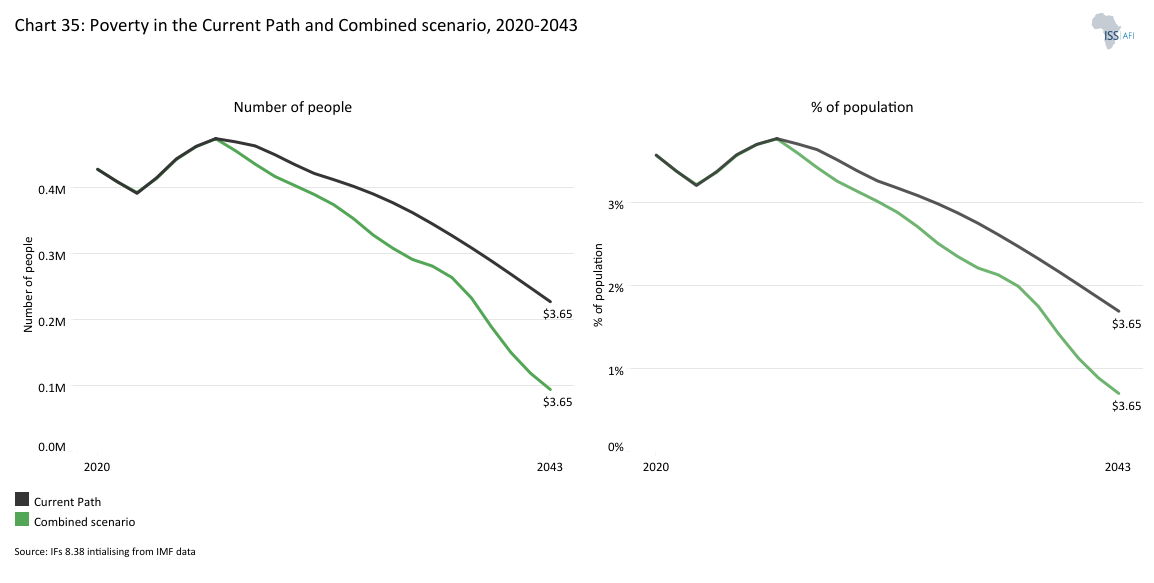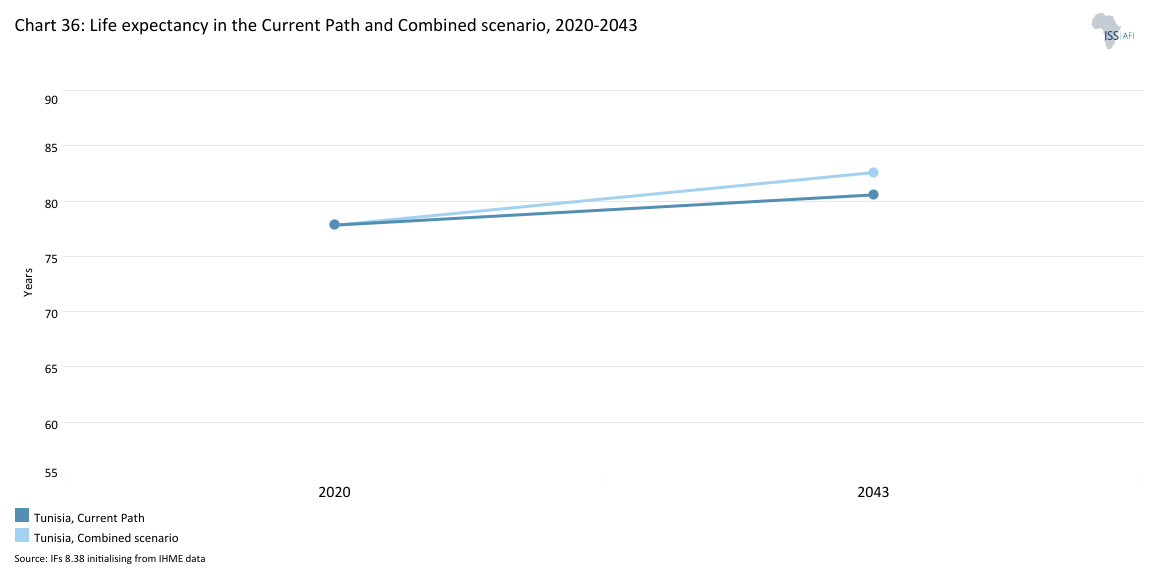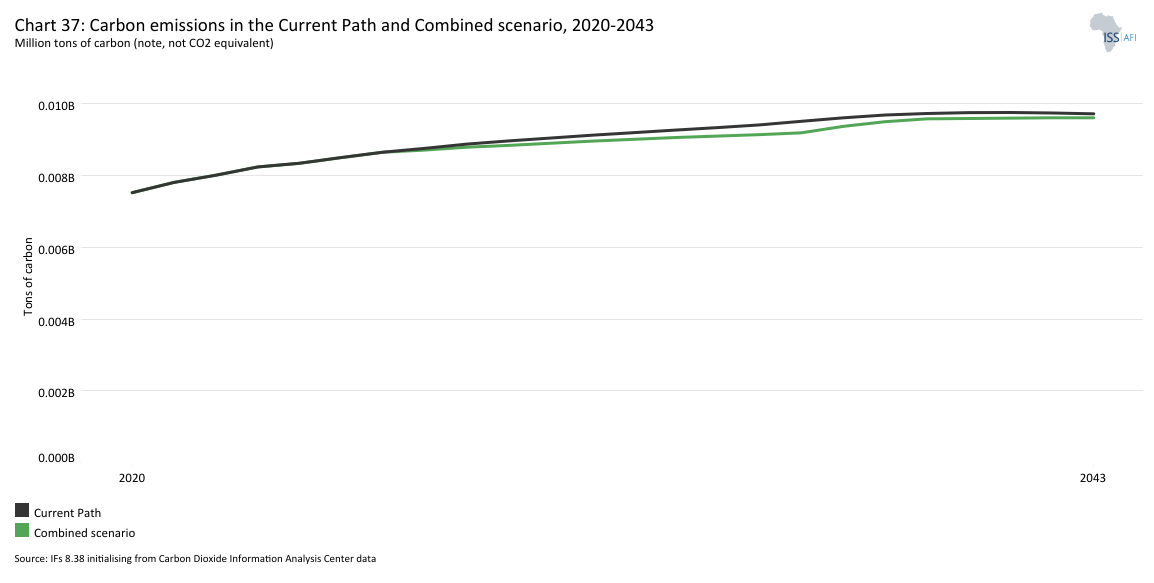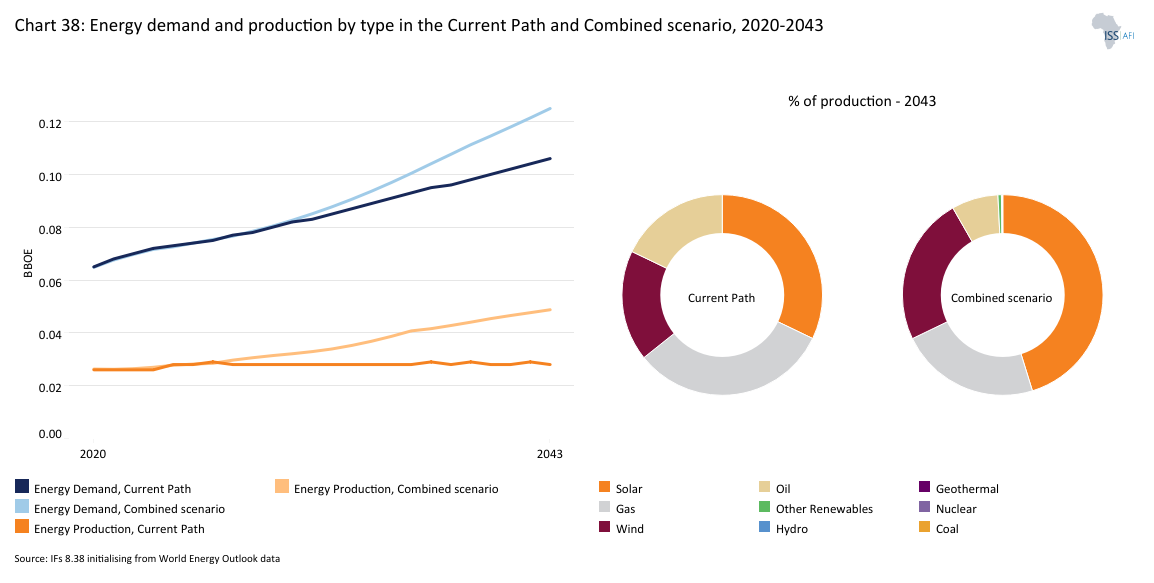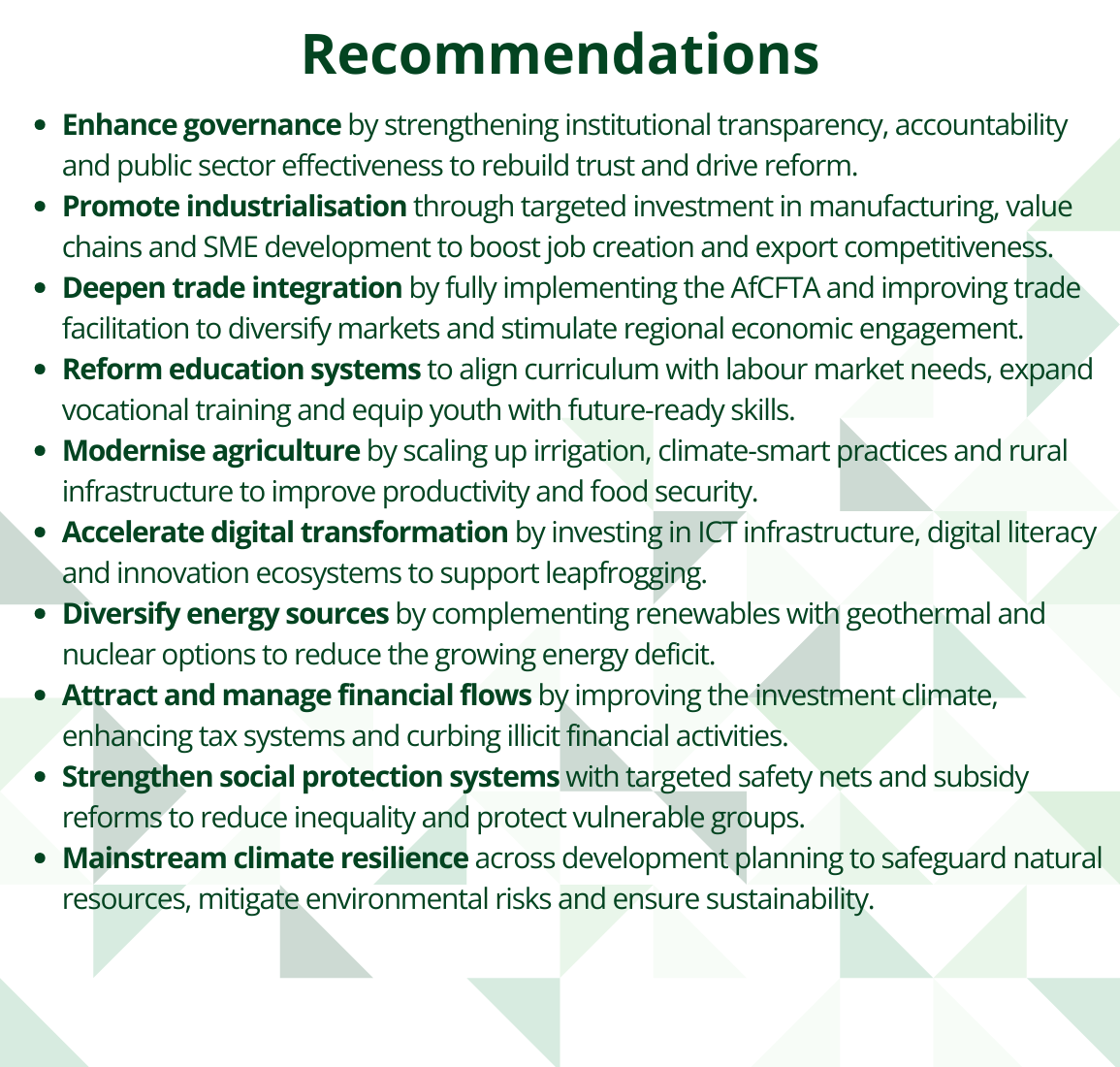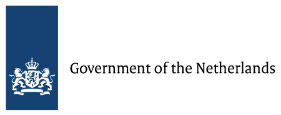 Tunisia
Tunisia
Feedback welcome
Our aim is to use the best data to inform our analysis. See our Technical page for information on the IFs forecasting platform. We appreciate your help and references for improvements via our feedback form.
This report analyses Tunisia’s current development path and future prospects, examining how various sectoral interventions could shape the country’s economic and social landscape through to 2043, the end of the third ten-year implementation plan of the African Union's Agenda 2063. The analysis is grounded in scenario modelling and explores eight key sectors: Demographics and Health, Agriculture, Education, Manufacturing, Large Infrastructure and Leapfrogging, the African Continental Free Trade Area (AfCFTA), Financial Flows, and Governance. In addition to evaluating the effects of each sectoral scenario individually, the report assesses the combined impact of these interventions on Tunisia’s long-term growth and development trajectory.
The report begins by introducing Tunisia, providing an overview of its geographic location, social and demographic structure and political history to establish the context for the development analysis. This background sets the stage for understanding the country’s current economic position and institutional landscape.
Following this, the report outlines Tunisia’s expected development trajectory without major policy changes, referred to as the Current Path scenario. This scenario spans the period from 2023 to 2043 and is based on data from reputable international and national sources, emphasising prioritising national statistics where available. The section covers a range of key indicators including demographics, GDP at market exchange rates (MER), informal sector dynamics, GDP per capita in purchasing power parity (PPP), poverty rates and alignment with Tunisia’s National Development Plan.
The third section presents the individual sectoral scenarios, each modelling the potential effects of targeted improvements in one of the eight identified areas. These scenarios provide insights into how sector-specific interventions could influence Tunisia’s developmental outcomes over the next two decades.
The fourth section is divided into two parts. The first part analyses the impact of both individual and combined scenarios on GDP per capita and poverty alleviation. The second part explores the wider socio-economic implications of the Combined scenario, examining changes in economic growth, structural economic transformation, the size of the informal economy, life expectancy, income inequality (measured by the Gini coefficient), carbon emissions, and energy production and demand.
The report concludes by summarising the key findings and offering policy insights to support Tunisia in pursuing a more inclusive, resilient, and sustainable development path. It underscores the importance of coordinated, multi-sectoral reforms to unlock the country’s long-term economic and social potential.
Visit the Technical section for additional information on the International Futures (IFs) modelling platform, which serves as the analytical foundation for this report's scenario simulations.
Summary
This page begins with an introductory assessment of the country’s context, examining current population distribution, social structure, climate and topography.
- Tunisia, located in North Africa, has a well-educated population, relatively strong institutions and a legacy of early post-independence investment in health, education and gender equality. However, its democratic transition since 2011 has been accompanied by political fragmentation, economic stagnation and rising public discontent.
This section is followed by an analysis of the Current Path for Tunisia which informs the country’s likely current development trajectory to 2043. It is based on current geopolitical trends and assumes that no major shocks would occur in a ‘business-as-usual’ future.
- Tunisia’s population structure is characterised by an ageing demographic, with the share of the working-age population declining slightly from 66% in 2023 to 65.7% in 2043. The demographic dividend is narrowing, requiring policies to improve labour force participation and productivity.
- In terms of GDP at market exchange rates (MER), Tunisia’s economy will expand from US$43.05 billion in 2023 to US$75.1 billion by 2043, reflecting a modest average annual growth rate of 2.8%.
- GDP per capita in Purchasing Power Parity (PPP) will increase gradually from US$9 900 in 2023 to US$12 870 in 2043, but this growth is insufficient to drive convergence with upper-middle-income countries.
- The informal sector contributed 23.2% to GDP and employed 36.5% of the labour force in 2023. These shares will decline to 20.3% and 32.9%, respectively, by 2043, indicating slow formalisation of the economy.
- Poverty levels, particularly at the US$3.65 per day threshold, will decline from 3.4% in 2023 to 1.7% in 2043. However, regional disparities and multidimensional poverty remain major concerns.
- Tunisia’s National Development Plan (NDP), anchored in Vision Tunisie 2035, outlines a strategic roadmap toward a high-income, inclusive and sustainable economy. It prioritises digital transformation, industrial diversification, regional equity and environmental resilience.
The next section compares progress on the Current Path with eight sectoral scenarios. These are Demographics and Health; Agriculture; Education; Manufacturing; the African Continental Free Trade Area (AfCFTA); Large Infrastructure and Leapfrogging; Financial Flows; and Governance. Each scenario is benchmarked to present an ambitious but reasonable aspiration in that sector, comparing Tunisia with other countries at similar levels of development and characteristics.
- The Demographics and Health scenario forecasts improved life expectancy and reduced infant mortality through investment in health infrastructure, WaSH services and prevention of non-communicable diseases (NCDs). Life expectancy rises to 82.2 years by 2043, 1.7 years above the Current Path.
- The Agriculture scenario increases food security by enhancing crop yields, expanding irrigation and adopting climate-smart techniques. By 2043, Tunisia transitions from a food deficit to a surplus, achieving full food self-sufficiency.
- The Education scenario enhances mean years of schooling to 11.9 years and improves quality scores across all levels. It narrows the gender gap and positions Tunisia to align human capital with labour market demands better.
- The Manufacturing scenario expands the industrial base and raises the manufacturing value-added share of GDP to 19.2% by 2043. It drives job creation, poverty reduction and higher fiscal revenues.
- The AfCFTA scenario increases trade openness and export diversification, lifting GDP per capita to US$13 500 by 2043. Tunisia's trade deficit shrinks as manufacturing and Information and Communication Technology (ICT) exports rise.
- The Large Infrastructure and Leapfrogging scenario boosts broadband connectivity and renewable energy production. It also supports growth in digital services and accelerates the green transition.
- The Financial Flows scenario increases FDI, slows remittance decline and reduces aid dependency. By 2043, GDP per capita rises to US$13 440, and government revenue grows by an additional US$1.35 billion above the Current Path.
- The Governance scenario strengthens institutional effectiveness, public service delivery and social equity. Governance scores rise, poverty declines to 1.4%, and GDP grows to US$77.33 billion by 2043.
The fourth section compares the impact of each of these eight sectoral scenarios with one another and subsequently with a Combined scenario (the integrated effect of all eight scenarios). The forecasts measure progress on various dimensions such as economic size (in market exchange rates), gross domestic product (GDP) per capita (in purchasing power parity), extreme poverty, carbon emissions, the changes in the structure of the economy, and selected sectoral dimensions such as progress with mean years of education, life expectancy, the Gini coefficient or reductions in mortality rates.
- The Combined scenario, which integrates all eight sectoral interventions, delivers the strongest development outcomes. It raises GDP (MER) to US$101 billion, boosts GDP per capita (PPP) to US$15 630, and reduces extreme poverty to 0.7% by 2043.
- Tunisia experiences significant structural transformation, with manufacturing, ICT and agriculture growth. The informal sector's role in GDP and employment shrinks notably, while the Gini coefficient declines to 0.3, signalling improved income equality.
- Life expectancy increases to 82.6 years, and carbon emissions decline by 110 000 tons compared to the Current Path, affirming the sustainability of this growth path. However, an energy deficit persists, highlighting the need to diversify the renewable energy mix beyond solar and wind.
The analysis concludes with a summarising section offering recommendations. A coordinated and multi-sectoral approach can greatly enhance Tunisia’s development prospects. Key policy priorities emerging from the scenario analysis include strengthening governance to rebuild public trust and enhance institutional capacity; accelerating industrialisation and manufacturing-led growth to generate employment and boost value-added exports; and expanding agricultural productivity and food self-sufficiency through sustainable, climate-resilient practices. In parallel, scaling up investments in digital infrastructure and renewable energy will be crucial to support technological leapfrogging and a green transition. Reforming the education system to better align with labour market needs and improve the quality of learning outcomes is also essential. Tunisia should deepen trade integration, particularly through full participation in the AfCFTA, to diversify markets and stimulate private sector dynamism. Mobilising and managing financial flows more effectively will help reduce aid dependency while expanding fiscal space. Finally, sustained investment in health and social protection systems will be vital to reduce vulnerability, improve human capital outcomes, and foster social cohesion. With political will and strategic coordination, Tunisia can transition into a more inclusive, competitive and sustainable economy by 2043.
All charts for Tunisia
- Chart 1: Political map of Tunisia
- Chart 2: Population structure in the Current Path, 1990–2043
- Chart 3: Population distribution map, 2023
- Chart 4: Urban and rural population in the Current Path, 1990-2043
- Chart 5: GDP (MER) and growth rate in the Current Path, 1990–2043
- Chart 6: Size of the informal economy in the Current Path, 2020-2043
- Chart 7: GDP per capita in Current Path, 1990–2043
- Chart 8: Extreme poverty in the Current Path, 2020–2043
- Chart 9: National Development Plan of TUNISIA
- Chart 10: Relationship between Current Path and scenarios
- Chart 11: Mortality distribution in the Current Path, 2023 and 2043
- Chart 12: Infant mortality rate in Current Path and Demographics and Health scenario, 2020–2043
- Chart 13: Demographic dividend in the Current Path and the Demographics and Health scenario, 2020–2043
- Chart 14: Crop production and demand in the Current Path, 1990-2043
- Chart 15: Import dependence in the Current Path and Agriculture scenario, 2020–2043
- Chart 16: Progress through the education funnel in the Current Path, 2023 and 2043
- Chart 17: Mean years of education in the Current Path and Education scenario, 2020–2043
- Chart 18: Value-add by sector as % of GDP in the Current Path, 2023 and 2043
- Chart 19: Value-add by the manufacturing sector in the Current Path and Manufacturing scenario, 2020–2043
- Chart 20: Exports and imports as % of GDP in the Current Path, 2000-2043
- Chart 21: Trade balance in the Current Path and AfCFTA scenario, 2020–2043
- Chart 22: Electricity access: urban, rural and total in the Current Path, 2000-2043
- Chart 23: Cookstove usage in the Current Path and Large Infra/Leapfrogging scenario, 2020–2043
- Chart 24: Access to mobile and fixed broadband in the Current Path and the Large Infra/Leapfrogging scenario, 2020–2043
- Chart 25: FDI, foreign aid and remittances as % of GDP in the Current Path and in the Financial Flows scenario, 1990-2043
- Chart 26: Government revenue in the Current Path and Financial Flows scenario, 2020–2043
- Chart 27: Government effectiveness score in the Current Path, 2002-2043
- Chart 28: Composite governance index in the Current Path and Governance scenario, 2023 and 2043
- Chart 29: GDP per capita in the Current Path and scenarios, 2020–2043
- Chart 30: Poverty in the Current Path and scenarios, 2020–2043
- Chart 31: GDP (MER) in the Current Path and Combined scenario, 2020–2043
- Chart 32: GDP per capita in the Current Path and Combined scenario, 2023-2043
- Chart 33: Value-add by sector in the Current Path and Combined scenario, 2023 and 2043
- Chart 34: Informal sector in the Current Path and Combined scenario, 2020–2043
- Chart 35: Poverty in the Current Path and Combined scenario, 2023 and 2043
- Chart 36: Life expectancy in the Current Path and Combined scenario, 2020–2043
- Chart 37: Carbon emissions in the Current Path and Combined scenario, 2020–2043
- Chart 38: Energy demand and production by type in the Current Path and Combined scenario, 2020-2043
- Chart 39: Policy recommendations
Chart 1 is a political map of Tunisia.
Tunisia is located in North Africa, bordered by Algeria to the west and south-west, Libya to the south-east, and the Mediterranean Sea to the north and east. The country spans an area of 163 610 km², with Tunis, situated along the north-eastern coastline, serving as the capital and largest city. The predominant languages are Tunisian Arabic, Berber and French, reflecting its historical and cultural diversity.
Tunisia gained independence from France in 1956 under the leadership of Habib Bourguiba, who later became the country’s first president. Bourguiba implemented an ambitious, state-led development strategy, emphasising social progress, secularism and gender equity, distinguishing Tunisia from many of its regional peers in North Africa and the Middle East. These early reforms contributed to positive education, healthcare and women’s rights outcomes.
However, despite these advances, Tunisia’s macroeconomic stability and improvements in human development masked deep-rooted structural issues. By the late 2000s, growing youth unemployment, regional inequality and entrenched corruption exacerbated a pervasive sense of exclusion and discontent, particularly among the educated but underemployed youth.
These underlying grievances culminated in the Freedom and Dignity Revolution of December 2010, which led to the ousting of long-time President Zine El Abidine Ben Ali in January 2011. Tunisia’s uprising catalysed for the broader Arab Spring, but it remains the only country in the region to have undergone a sustained, albeit turbulent, transition to democracy.
In the years following the revolution, Tunisia adopted a progressive constitution (2014) and held multiple rounds of competitive elections. Nevertheless, the post-revolutionary period has been marred by economic stagnation, political fragmentation and social unrest, with successive governments struggling to deliver on the promise of improved governance and living standards.
Since 2021, Tunisia has experienced a significant democratic regression. President Kaïs Saïed suspended parliament, dismissed the government and subsequently introduced a new constitution that significantly expanded presidential powers. These actions have drawn criticism from civil society, opposition groups and international observers, raising concerns about autocratic consolidation and the erosion of democratic institutions.
Economic conditions have also deteriorated. Public debt is rising, unemployment remains high, especially among the youth, and inflation has eroded household purchasing power. Talks with the International Monetary Fund (IMF) for financial support have stalled over disagreements concerning subsidy reform and fiscal austerity. These challenges are compounded by the spillover effects of regional instability and the impacts of climate change on agriculture and water security.
Although Tunisia possesses the foundations of an upper-middle-income country, including a relatively skilled labour force and a history of institutional reform, it continues to underperform economically. The persistent disconnect between human capital potential and economic output reflects structural weaknesses, limited investment and an underdeveloped private sector.
While Tunisia’s demographic and institutional profile positions it for long-term progress under stable conditions, current political and economic headwinds pose substantial risks. Without meaningful reforms to improve governance, unlock economic opportunity and rebuild public trust, the country’s development prospects may remain constrained in the decades ahead.
Chart 2 presents the Current Path of the population structure, from 1990 to 2043.
Tunisia’s population was estimated at 12.3 million in 2023 and will increase to approximately 13.4 million by 2043 on the Current Path. As illustrated in Chart 2, there was a notable surge in the working-age population (15–64 years) in the years leading up to the Freedom and Dignity Revolution in 2010. The substantial growth in this demographic cohort between 1980 and 2006 played a significant role in the socio-political dynamics that culminated in the ousting of President Zine El Abidine Ben Ali in January 2011.
Tunisia’s total fertility rate (TFR) declined below the replacement threshold of 2.1 children per woman in the early 2020s. This demographic shift will result in a marginal decrease in the proportion of the working-age population by 2043. Nevertheless, the country will maintain a substantial share of its population within the 15–64 age (working-age) bracket.
In 2023, the working-age population represented approximately 66% of the total population; by 2043, this proportion will decline slightly to 65.7% under the Current Path. Concurrently, Tunisia will experience a rise in the proportion of older adults. The Current Path suggests that the elderly population (65 and above) will constitute about 17.8% of the total population by 2043. This ageing trend will significantly affect economic productivity and the healthcare system, particularly given the increasing burden of non-communicable diseases (NCDs), which are generally more costly to diagnose and treat.
Tunisia reached its peak demographic dividend in the 2010-2011 period, with approximately 2.27 working-age individuals for every dependant (i.e., approximately 23 working individuals per 10 dependants). By 2023, this ratio had declined to approximately 1.94 and will rise slightly between 2025 and 2035 before gradually tapering off. Tunisia is among only eight African countries currently positioned to benefit from a demographic dividend, commonly associated with a dependency ratio of 1.7 or more working-age persons per dependant. However, despite this favourable demographic structure, the potential economic gains associated with labour-driven growth have not translated into corresponding increases in income.
Chart 3 presents a population distribution map for 2023.
As of 2023, Tunisia had an average population density of approximately 0.79 persons per hectare, based on its total land area of 163 610 km². However, this population is unevenly distributed, with significantly higher concentrations in urban coastal regions and major metropolitan centres.
The country is among the most urbanised countries in both Africa and the North African region, with an urbanisation rate of 70.5% in 2023, a figure that has continued to rise steadily since 2013. The country's three principal urban agglomerations, Greater Tunis, Sfax and Sousse, serve as the primary economic hubs, collectively contributing approximately 85% of the national GDP. These metropolitan regions attract most public and private investment, particularly in infrastructure, services and industrial activity.
Approximately 75% of Tunisia’s population resides in coastal areas, reflecting a historical pattern of development focused on maritime trade, tourism and export-oriented industries. In contrast, inland and southern regions remain underdeveloped, with limited access to quality infrastructure, healthcare and education. These regional disparities have contributed to significant socio-economic imbalances and continue to fuel internal migration toward urban centres.
Recent government development strategies, including those outlined in the National Development Plan and supported by international partners, have identified the reduction of regional inequality as a priority. Nonetheless, implementation has been uneven, and the gap between urban and rural areas remains a central challenge for inclusive and balanced national development.
Chart 4 presents the urban and rural population in the Current Path, from 1990 to 2043.
Tunisia has consistently maintained a higher level of urbanisation than regional and global benchmarks, with its urban population share exceeding the averages for Africa and lower-middle-income countries by approximately 20 percentage points. Unlike typical development trajectories, however, this relatively advanced urbanisation has not translated into more equitable income growth. Instead, its primary dividends have been improvements in educational attainment and enhanced access to basic infrastructure and public services.
The Current Path suggests that Tunisia’s urbanisation trend will continue to rise. By 2043, an estimated 76.6% of the population will reside in urban areas, while only 23.4% will remain in rural communities. The urban rate in 2023 was 72%. This shift underscores the need for policies to better harness urban growth for inclusive economic development, particularly in light of ongoing structural challenges and rising urban unemployment.
Chart 5 presents GDP in market exchange rates (MER) and growth rate in the Current Path, from 1990 to 2043.
Tunisia’s weak economic performance is fundamentally linked to a highly restrictive regulatory environment, the persistent dominance of state-owned enterprises, outdated legal frameworks, entrenched corruption, particularly within customs administration and limited market competition. In addition, rigid labour laws and a constrained socio-political space contribute to systemic exclusion and inequality. These structural impediments have stifled productivity, discouraged private investment and constrained long-term economic growth.
Relative to the averages for lower-middle-income countries, Tunisia derives the least growth contribution from labour and capital inputs. At the same time, multifactor productivity (or technology) accounts for the largest share of economic expansion. This reflects, in part, the country’s chronically low labour force participation rate, particularly among women, as well as subdued levels of capital formation. Tunisia’s female labour participation remains significantly below that of males, further reducing the potential of its human capital base.
Since the 2011 revolution, Tunisia’s development strategy has focused on promoting private sector-led growth, strengthening civil society and deepening international partnerships. However, progress has been limited. The country grapples with persistently high unemployment, rising public expenditure and debt levels, inflationary pressures, declining foreign reserves and fiscally unsustainable subsidies, especially in the energy sector.
The Current Path depicts modest economic growth over the next two decades, with Tunisia’s GDP expanding at an average annual rate of just over 2.8% between 2024 and 2043. From a baseline of US$43.05 billion in 2023, the economy will reach US$75.1 billion by 2043. This trajectory highlights the urgency of implementing deep structural reforms to unlock higher, more inclusive, and sustainable growth.
Chart 6 presents the size of the informal economy as a percentage of GDP and per cent of total labour (non-agriculture), from 2020 to 2043. The data in IFs is an estimate and therefore may differ from other sources.
Since the early 1990s, Tunisia’s informal sector has remained relatively small compared to regional and income-group peers. This reflects, in part, the country’s historically stronger institutional capacity, relatively better public service provision, and a more structured labour market than many of its African counterparts. However, the informal sector remains a critical source of employment, particularly in the aftermath of economic shocks, including the 2011 revolution and subsequent periods of fiscal stress and slow growth.
In 2023, the informal sector contributed 23.2% to Tunisia’s GDP, significantly below the average of 30.6% for lower-middle-income countries in Africa. By 2043, this share will decline modestly to 20.3% for Tunisia and 27% for the broader peer group, reflecting a gradual formalisation of economic activity.
Regarding employment, 36.5% of Tunisia’s labour force was engaged in the informal sector in 2023. This share will fall to 32.9% on the Current Path by 2043. Again, this is considerably lower than the average for lower-middle-income African countries, where informal employment stood at 57.5% in 2023 and will decline slightly to 54.2% over the same period.
Tunisia’s relatively lower levels of informality suggest a degree of institutional strength and regulatory control. However, it also reflects the limited absorptive capacity of the formal private sector and the persistence of structural unemployment. As the country seeks to boost inclusive growth, targeted reforms will be essential to expand decent work opportunities, strengthen the business environment and accelerate the transition from informal to formal employment.
Chart 7 presents GDP per capita in the Current Path, from 1990 to 2043, compared with the average for the Africa income group.
Tunisia’s GDP per capita has followed a trajectory of early promise, followed by recent stagnation. Since 1990, the country has experienced steady growth in per capita income, underpinned by investments in education, health and infrastructure, as well as a relatively diversified economy. This upward trend was particularly marked in the two decades leading up to 2010, during which per capita income increased significantly, placing Tunisia among the top ten African countries by income per person and well above the averages for lower-middle-income countries both globally and on the continent.
However, the post-2011 period ushered in a phase of economic uncertainty and stagnation. Political transitions, structural rigidities and declining competitiveness contributed to a slowdown in income growth. The COVID-19 pandemic further exacerbated these challenges, causing per capita income to fall from US$11 110 in 2019 to US$9 810 in 2020. Recovery has been slow, and the Current Path indicates that Tunisia is unlikely to regain its 2019 income levels before 2034.
Per capita income will rise gradually, reaching approximately US$12 870 by 2043. Despite this improvement, Tunisia’s income trajectory is increasingly aligning with the average for lower-middle-income countries, rather than diverging positively as might be expected given its substantial human capital endowment and early gains in socio-economic development.
This lack of convergence is a cause for concern. It suggests that Tunisia is not fully capitalising on its potential, particularly in areas such as labour productivity, innovation and private sector dynamism. Unlocking more robust and inclusive growth will require structural reforms to enhance economic competitiveness, reduce informality and generate higher-value employment, particularly for the country’s well-educated youth population.
Chart 8 presents the rate and number of extremely poor people in the Current Path from 2020 to 2043.
In 2022, the World Bank updated the poverty lines to 2017 constant dollar values as follows:
- The previous US$1.90 extreme poverty line is now set at US$2.15, also for use with low-income countries.
- US$3.20 for lower-middle-income countries, now US$3.65 in 2017 values.
- US$5.50 for upper-middle-income countries, now US$6.85 in 2017 values.
- US$22.70 for high-income countries. The Bank has not yet announced the new poverty line in 2017 US$ prices for high-income countries.
Monetary poverty only tells part of the story. In addition, the global Multidimensional Poverty Index (MPI) measures acute multidimensional poverty by measuring each person’s overlapping deprivations across ten indicators in three equally weighted dimensions: health, education and standard of living. The MPI complements the international US$2.15 a day poverty rate by identifying who is multidimensionally poor and also shows the composition of multidimensional poverty. The headcount or incidence of multidimensional poverty is often several percentage points higher than that of monetary poverty. This implies that individuals living above the monetary poverty line may still suffer deprivations in health, education and/or standard of living.[1]
Tunisia has made considerable progress in reducing poverty over the past three decades. Since 1990, the country has significantly lowered its poverty headcount, driven by sustained investments in human development, relatively inclusive social policies and broad access to basic services. As a result, Tunisia has already met the headline Sustainable Development Goal (SDG) of eradicating extreme poverty as defined by the international poverty line of US$2.15 per person per day (2017 PPP). Currently, less than 1% of the population lives below this threshold.
However, while eradicating extreme poverty represents a major milestone, other dimensions of poverty and inequality remain. Disparities persist across regions, particularly between urban coastal areas and the more impoverished interior and southern regions, as well as among various demographic groups. Poverty measured at higher thresholds, such as the World Bank’s US$3.65 per person per day poverty line for lower-middle-income countries, remains a challenge and will persist into the foreseeable future.
Although Tunisia’s long-standing universal subsidy system has contributed to mitigating poverty, it has also been fiscally burdensome and economically inefficient. The current system disproportionately benefits higher-income households and crowds out targeted social spending. As Tunisia navigates a constrained fiscal environment, reforming its subsidy framework toward more targeted and efficient social safety nets will be critical to achieving sustained poverty reduction and narrowing inequality.
The Current Path indicates that poverty, measured at the US$3.65 threshold, will rise slightly until around 2026 due to ongoing economic pressures, before resuming a gradual decline. By 2043, the proportion of Tunisians living below this line will fall to 1.7% (approximately 226 967 people), down from 3.4% (about 414 847 people) in 2023. This trajectory reflects continued, albeit modest, progress and underscores the need for deeper structural reforms to ensure a more equitable and inclusive growth path.
Chart 9 depicts the National Development Plan.
Tunisia’s long-term development agenda is anchored in Vision Tunisie 2035, a strategic framework launched in 2022 that outlines the country’s aspirations to become a high-income, inclusive and sustainable economy by 2035. This vision builds on Tunisia’s historical strengths, such as a well-educated population and relatively strong institutions, while addressing persistent structural weaknesses that have constrained economic transformation and social cohesion.
At the heart of Vision Tunisie 2035 is strongly emphasising human capital development. The government recognises that education, innovation and regional equity are essential to fostering a productive and inclusive society. The plan aims to enhance the quality and accessibility of education, emphasising digital literacy and skills that align with labour market needs. It also seeks to reduce regional disparities in education outcomes and healthcare access, particularly between coastal urban centres and the interior and southern regions.
A key pillar of the vision is the transition to a knowledge-based and digitally enabled economy. The plan prioritises investment in digital infrastructure and promoting digital transformation across public services and economic sectors. By fostering a conducive environment for digital entrepreneurship, the government hopes to create jobs, improve service delivery and boost Tunisia’s competitiveness in global markets.
Economic diversification and competitiveness represent another central theme of Vision 2035. Tunisia aims to shift from a low-value-added, consumption-driven economy to one export-oriented and integrated into global value chains. This involves modernising the industrial base, expanding the role of high-potential sectors such as ICT, pharmaceuticals, automotive components and agribusiness, and enhancing the productivity of small and medium-sized enterprises (SMEs). Structural reforms to improve the investment climate, reduce bureaucratic inefficiencies, and modernise financial markets are also planned to stimulate private sector growth and attract foreign direct investment.
Environmental sustainability is also a core priority. Tunisia aims to build a green economy that is resilient to climate change and anchored in the sustainable use of natural resources. Key objectives include expanding renewable energy generation (especially solar and wind), improving water resource management and promoting sustainable agriculture. Climate adaptation strategies, including strengthening coastal protections and promoting drought-resistant crops, are being developed in response to Tunisia’s growing vulnerability to environmental shocks.
The vision strongly emphasises social justice and inclusion. Policies are designed to improve living standards, reduce multidimensional poverty and expand access to social services. This includes reforming the subsidy system, which has been fiscally unsustainable and often regressive, in favour of more targeted social protection measures that directly benefit vulnerable populations. Measures to improve gender equality, especially in economic participation, are also being prioritised.
Another strategic focus is balanced regional development. Tunisia’s historical pattern of coastal-centric development has left large swathes of the country underdeveloped. The development plan seeks to rectify this by increasing public investment in lagging regions, promoting local economic development and decentralising public services to empower municipalities. Infrastructure investments, particularly in transport, water and energy, will be key in facilitating regional integration and economic opportunity.
The 2023–2025 Development Plan, which serves as the medium-term implementation framework for Vision 2035, sets more immediate priorities. It focuses on stabilising the macroeconomic environment by implementing fiscal and governance reforms, boosting revenue mobilisation and improving the efficiency of public spending. Given the pressures on public finances, the government plans to gradually reduce untargeted subsidies, especially in the energy sector, while strengthening social safety nets through direct cash transfers and better targeting mechanisms.
Sector-specific priorities under the 2023–2025 plan include revitalising agriculture through modernisation, climate-smart practices and improved rural infrastructure. The industrial sector is set to benefit from incentives for technological upgrading, cluster development and export promotion. Tourism focuses on diversifying offerings beyond traditional beach tourism to include cultural, ecological and medical tourism while improving service quality and infrastructure. Transport and logistics infrastructure, critical for boosting trade and regional development, is receiving significant public investment, with ongoing efforts to modernise port infrastructure and improve road and rail connectivity.
Energy policy is increasingly focused on renewable sources, with the government targeting a significant increase in solar and wind capacity as part of its energy transition strategy. Investment incentives, public-private partnerships,and regulatory reforms are being pursued to attract green financing and private investment in this sector.
To support implementation, Tunisia has mobilised public investment amounting to approximately US$12.3 billion for the current plan period, with allocations concentrated in infrastructure, education, healthcare and digital transformation. Strong international partnerships, including with the European Union, World Bank and African Development Bank, are being leveraged to finance development priorities and support structural reform efforts.
Although detailed frameworks for the period beyond 2025 have not yet been officially released, Tunisia is expected to continue to build upon Vision 2035 through successive medium-term plans. These are likely to focus on deepening the structural transformation of the economy, consolidating gains in human development, and adapting to the increasingly complex challenges posed by climate change, global economic shifts and domestic socio-political dynamics.
Chart 11 presents the mortality distribution in the Current Path for 2023 and 2043.
The Demographics and Health scenario envisions ambitious improvements in child and maternal mortality rates, enhanced access to modern contraception, and decreased mortality from communicable diseases (e.g., AIDS, diarrhoea, malaria, respiratory infections) and non-communicable diseases (e.g., diabetes), alongside advancements in safe water access and sanitation. This scenario assumes a swift demographic transition supported by heightened investments in health and water, sanitation and hygiene (WaSH) infrastructure.
Visit the themes on Demographics and Health/WaSH for more details on the scenario structure and interventions.
Tunisia introduced free healthcare on independence and has since made significant investments in the sector. Since then, the country's mortality profile has increasingly shifted toward non-communicable diseases (NCDs) since the late 60s, reflecting broader demographic and epidemiological transitions.
Currently, the country’s disease burden is dominated by NCDs such as cardiovascular conditions, malignant neoplasms (cancers), chronic respiratory diseases and mental health disorders. This trend aligns with changes in population structure, urbanisation and lifestyle factors, including dietary habits, physical inactivity, tobacco use and environmental pollution.
The Current Path indicates that mortality from key NCDs will rise significantly over the next two decades. Cardiovascular-related deaths will increase from 37 080 in 2023 to 62 200 by 2043, while deaths from malignant neoplasms will increase from 10 780 to 16 480 over the same period. This sharp increase is largely driven by population ageing, rising prevalence of risk factors, and gaps in the prevention and early detection of chronic diseases.
In addition to cardiovascular disease and cancer, other NCDs, including mental health conditions, respiratory diseases and metabolic disorders, are becoming more pronounced. Deaths attributed to mental health-related conditions will rise from 3 740 in 2023 to 9 580 by 2043 under the Current Path. Similarly, fatalities from respiratory diseases will increase from 2 860 to 5 910, and other NCD-related deaths from 4 070 to 6 130 over the same period. These trends underline a growing and diversified NCD burden that poses significant challenges for Tunisia's health system.
Though relatively advanced by regional standards, Tunisia's health system faces critical challenges in responding to this evolving disease burden. These include underinvestment in preventive healthcare, uneven quality of services between urban and rural areas, limited integration of NCD management into primary care, and a shortage of specialised personnel and diagnostic infrastructure. The COVID-19 pandemic also exposed underlying vulnerabilities in the public health system, particularly concerning emergency preparedness, supply chain resilience and digital health infrastructure.
To effectively address the rising burden of NCDs, Tunisia will need to prioritise comprehensive health sector reforms. Key priorities include expanding access to early diagnosis and screening programs, integrating NCD care into primary healthcare delivery, and increasing investments in mental health services. Strengthening the country’s epidemiological surveillance and health information systems will also be essential for timely intervention and resource allocation. Moreover, public health campaigns focused on behavioural change, targeting tobacco use, physical inactivity and unhealthy diets, are critical to reducing the incidence of NCDs over the long term.
As the country prepares for an ageing population and rising healthcare demands, greater strategic planning, investment and intersectoral coordination will be required to build a resilient, equitable and sustainable health system.
Overall, Tunisia demonstrates strong performance across key health indicators. Life expectancy in the country is relatively high, reaching approximately 78.1 years in 2023. The Current Path suggests further improvement, with average life expectancy increasing to 80.6 years by 2043, nearly four years above the global average forecast.
Consistent with global trends, female life expectancy in Tunisia will remain higher than that of males. Between 2023 and 2043, female life expectancy will increase from 80.4 to 82.9 years, while male life expectancy will rise from 75.8 to 78.1 years under the Current Path. These trends reflect continued gains in healthcare access, disease prevention and general living standards, although gender disparities in health outcomes will persist.
Chart 12 presents the infant mortality rate in the Current Path and in the Demographics and Health scenario, from 2020 to 2043.
The infant mortality rate is the probability of a child born in a specific year dying before reaching the age of one. It measures the child-born survival rate and reflects the social, economic and environmental conditions in which children live, including their health care. It is measured as the number of infant deaths per 1 000 live births and is an important marker of the overall quality of the health system in a country.
Tunisia has already achieved the 2030 Sustainable Development Goal (SDG) target of reducing infant mortality to below 25 deaths per 1 000 live births, well ahead of schedule. It currently holds the lowest infant mortality rate among African lower-middle-income countries, a reflection of the country’s relatively strong healthcare infrastructure, effective immunisation programs and improvements in maternal and child health services.
Under the Demographics and Health scenario, Tunisia will make further gains in reducing infant mortality. The rate will decline from 9 deaths per 1 000 live births in 2023 to approximately 5.3 deaths by 2043. This compares favourably with the Current Path of 6.3 deaths per 1 000 live births over the same period. These improvements reflect the potential impact of continued maternal and child health investments, expanded access to quality prenatal and neonatal care and improved socio-economic conditions.
Moreover, the Demographics and Health scenario will be essential in improving life expectancy in Tunisia. Under this scenario, life expectancy will rise even further, reaching 1.67 years above the Current Path estimate of 80.56 years by 2043. This enhanced outcome benefits both women and men. Female life expectancy will exceed the Current Path of 82.94 years by an additional 1.46 years, while male life expectancy will rise 1.89 years above the Current Path estimate of 78.12 years. These gains reflect the positive impact of improved health services, better disease prevention and enhanced living conditions across the population.
Chart 13 presents the demographic dividend in the Current Path and in the Demographics and Health scenario, from 2020 to 2043.
The dividend is the window of economic growth opportunity that opens when the ratio of working-age persons to dependents increases to 1.7 to 1 and higher.
Demographers commonly distinguish between the first, second and even third demographic dividends. This analysis focuses on the first demographic dividend, which refers to the economic growth potential resulting from changes in the population’s age structure, specifically, an increase in the proportion of the working-age population (aged 15–64) relative to dependants (children under 15 and adults over 64). A demographic window of opportunity typically opens when this working-age to dependant ratio exceeds 1.7 to one, allowing for greater productivity, higher savings and increased per capita income.
Tunisia experienced a peak demographic window in 2010–2011, when the ratio of working-age individuals to dependants reached 2.3 to one. The country will undergo a second historical peak in the ratio around 2034–2036, reaching approximately 2.1 working-age persons per dependant under both the Current Path and the Demographics and Health scenario. Notably, the Demographics and Health scenario begins to exert a more positive impact from 2030 onward, as improvements in health and fertility outcomes contribute to a more favourable age structure. However, after this peak, the demographic dividend begins to decline. By 2043, the working-age to dependant ratio will decrease to 1.89 under the Demographics and Health scenario, slightly below the Current Path of 1.92.
This modest decline reflects several interrelated factors. First, population ageing becomes more pronounced in the years following the demographic peak, increasing the proportion of elderly dependants. Second, fertility rates, while reduced in earlier decades, may stabilise at lower levels (1.7 births per woman under both the Current Path and the Demographics and Health scenario), thereby slowing the growth of the working-age population. Third, labour force participation rates, particularly among women and youth, remain suboptimal, limiting the economic benefits that could otherwise be derived from the existing age structure. Finally, structural challenges in Tunisia’s economy, such as high unemployment, informality and underutilisation of skilled labour, also inhibit the full realisation of the demographic dividend.
These dynamics suggest that Tunisia's window of opportunity for maximising the first demographic dividend is finite and will begin to close in the late 2030s. To sustain and extend the benefits of this period, the country must accelerate investments in education, health and labour market reforms, particularly those that boost job creation, particularly for women, expand formal employment and improve productivity across sectors. Doing so will be essential for capturing the current dividend and laying the groundwork for a potential second demographic dividend driven by increased savings and capital accumulation in an ageing society.
Chart 14 presents crop production and demand in the Current Path from 1990 to 2043.
The Agriculture scenario envisions an agricultural revolution that ensures food security through ambitious yet feasible increases in yields per hectare, thanks to improved management, seed, fertiliser technology and expanded irrigation. Efforts to reduce food loss and waste are emphasised, with increased calorie consumption as an indicator of self-sufficiency and prioritising it over food exports. Additionally, enhanced forest protection signifies a commitment to sustainable land use practices.
Visit the theme on Agriculture for our conceptualisation and details on the scenario structure and interventions.
Agriculture remains a vital component of Tunisia’s economy and social fabric. The sector contributes approximately 11% to national GDP and employs around 16% of the labour force, which is particularly important in supporting rural livelihoods and ensuring food security. Tunisia is among the world’s leading producers and exporters of olive oil. It is one of the few African countries that has achieved self-sufficiency in dairy products, fruits and vegetables. However, the country remains heavily dependent on wheat imports, rendering its food system vulnerable to external price shocks and supply disruptions.
Between 1990 and 2023, both agricultural production and domestic demand have seen notable growth. Total agricultural output rose from 6.4 million metric tons in 1990 to 14.4 million metric tons in 2023, while demand increased from 8.2 to 19.8 million metric tons over the same period. This growing imbalance (demand is slowly outpacing production) has led to a widening food deficit, which stood at 4.8 million metric tons in 2023. Nevertheless, the Current Path indicates an improvement by 2043, with the food deficit narrowing to 2.5 million metric tons, as production and demand rise to 19.4 and 21.8 million metric tons, respectively.
As in many African economies, Tunisia's agriculture is predominantly crop-based. It plays a crucial role not only in economic output but also in providing food security and employment, especially in rural areas. Recent developments in the sector include increased investment in agro-export value chains, particularly olives, dates and citrus, as well as renewed policy focus on agricultural resilience and climate-smart farming practices.
Crop yields have improved moderately over the past three decades, increasing from 1.3 metric tons per hectare in 1990 to 2.6 metric tons in 2023. Variable climatic conditions, limited water availability and slow uptake of modern agricultural technologies have shaped this growth. While export-oriented crops such as olives and dates have performed relatively well, staple crops like wheat and barley are constrained by recurrent droughts, soil degradation and limited irrigation infrastructure.
Looking ahead, further improvements in agricultural productivity will depend on adopting sustainable water management practices, greater investment in agricultural research and innovation, and the broader application of modern farming techniques, including precision agriculture and climate-resilient seeds. Under the Current Path, crop yields will increase to 3.4 metric tons per hectare by 2043.
Within this period, total crop production will rise from 12.1 million metric tons in 2023 to 16.3 million metric tons by 2043, while demand will increase from 16.5 to 18.5 million metric tons. As a result, the crop deficit will decline significantly, from 4.4 million metric tons in 2023 to 1.9 million metric tons in 2043. This narrowing of the crop production and demand gap indicates that, with appropriate policy interventions and sustained investment, Tunisia has the potential to strengthen its food security and enhance the resilience of its agricultural sector.
Tunisia has made significant progress in expanding and modernising its irrigation infrastructure. The total land area equipped for irrigation increased from approximately 340 870 hectares in 1990 to 406 550 hectares in 2023, with a peak of 494 720 hectares in 2017. Despite this progress, water scarcity remains a critical constraint to agricultural productivity and sustainability. On the Current Path, the irrigated area will reach 442 100 hectares by 2043, an improvement from current levels, yet still below both the 2017 peak and the estimated national irrigation potential of 560 000 hectares. The Agriculture scenario increases total irrigated land to 483 000 hectares, an 18% improvement on the Current Path.
Among lower-middle-income countries in Africa, Tunisia currently ranks third after Egypt and Morocco in total irrigated land. However, further expansion and efficiency improvements in irrigation will require a strategic focus on sustainable water resource management. This includes greater investment in desalination technologies, rehabilitation of existing irrigation networks and the wider adoption of climate-smart practices such as drip and deficit irrigation. Ensuring sustainable water use will be essential to safeguarding Tunisia’s agricultural sector and securing long-term food and water security in the face of growing environmental and climate pressures.
Chart 15 presents the import dependence in the Current Path and the Agriculture scenario, from 2020 to 2043.
Improved agricultural yields directly affect food security and Tunisia’s dependence on food imports. Under the Agriculture scenario, crop production will rise significantly from 12.1 million metric tons in 2023 to 19.9 million metric tons by 2043. This represents a notable improvement over the Current Path, which forecasts production reaching only 16.3 million metric tons by the same year.
The successful implementation of the interventions outlined in the Agriculture scenario, which include enhanced input use, improved irrigation efficiency, adoption of climate-resilient practices and expansion of agricultural extension services, will be essential in closing the crop production gap.
These measures will eliminate the country’s crop deficit by the 2037/2038 season. By 2043, Tunisia could transition from a deficit of 4.4 million metric tons in 2023 to a surplus of 1.81 million metric tons. In contrast, remaining on the Current Path would still leave the country with a shortfall of approximately 1.9 million metric tons in 2043. This divergence highlights the transformative potential of targeted agricultural investments in achieving food security.
As of 2023, Tunisia imported approximately 26.7% of its total crop demand, making it vulnerable to global market volatility and external supply shocks. Critically, the Agriculture scenario enables Tunisia to eliminate its dependence on crop imports by 2040, achieving full self-sufficiency and surpassing domestic demand by approximately 6% by 2043, a milestone last achieved during the 1963–64 season. In comparison, the Current Path suggests a decrease in net agricultural import dependency to 13.6% by 2043.
From a food security perspective, this outcome would be significantly more favourable. Achieving self-sufficiency would shield the country from external price fluctuations, ensure greater resilience to supply chain disruptions, and enable Tunisia to more reliably meet the dietary and nutritional needs of its growing population. In the context of rising global food insecurity and supply chain vulnerabilities, exacerbated by climate change, geopolitical tensions and commodity price volatility, enhancing domestic agricultural capacity remains a strategic imperative for Tunisia’s long-term stability and development.
Chart 16 depicts the progress through the educational system in the Current Path, for 2023 and 2043.
The Education scenario represents reasonable but ambitious improvements in intake, transition, and graduation rates from primary to tertiary levels and better quality of education at primary and secondary levels. It also models substantive progress towards gender parity at all levels, additional vocational training at the secondary school level, and increases in the share of science and engineering graduates.
Visit the theme on Education for our conceptualisation and details on the scenario structure and interventions.
In 2024, Tunisia’s education system ranked 71st globally, a reflection of the country's sustained commitment to education as a national priority. Tunisia continues to allocate approximately 20% of its national budget to the education sector, highlighting one of the highest levels of public investment in education across Africa. The country ranks 49th globally for schooling expectancy and 51st for the student-to-teacher ratio at the primary level, underscoring its relatively strong emphasis on foundational education.
Since gaining independence in 1956, Tunisia has made remarkable strides in expanding educational access and improving outcomes. Landmark reforms have included significant investment in early childhood education and the introduction of free and compulsory education for children between the ages of six and sixteen. These reforms have resulted in Tunisia having one of the most educated populations in North Africa, ranking second after Libya within the region and ninth on the African continent overall, measured by the average number of years of schooling attained by adults aged 15 and older.
Despite these successes, challenges remain, particularly concerning the quality and inclusivity of education. The Current Path shows that the average number of years of schooling attained by youth aged 14 to 24 years, a key measure of future human capital, will remain stagnant at 11.6 years between 2023 and 2043. This stagnation is accompanied by a persistent and slightly widening gender gap favouring females. In 2023, the mean years of education for males trailed behind females by 0.38 years, and this gap will widen slightly to 0.41 years by 2043.
Regarding quality, Tunisia’s education system continues to improve, albeit gradually. The Current Path shows that the primary education quality score will rise from 36.7 in 2023 to 41.5 by 2043, while secondary education quality will increase modestly from 47 to approximately 50 over the same period. This positive trend places Tunisia above the average for lower-middle-income countries in Africa, demonstrating the impact of its sustained public investment in education. Nevertheless, the slow pace of improvement signals the need for renewed policy focus, especially to align educational quality with the demands of a modern economy.
A pressing concern is the widening gender gap in educational outcomes, increasingly favouring females. Between 2023 and 2043, the gender gap in primary education quality will increase from 1.5 points to 1.6 points, while the gap in secondary education quality will widen from 0.8 points to 1.01 points under the Current Path. While both boys and girls are benefiting from overall improvements, girls are progressing at a faster rate. These trends are corroborated by external assessments, including the World Economic Forum’s Global Gender Gap Report 2023, which ranked Tunisia 128th globally, a decline of eight places from the previous year. Although Tunisia has achieved near gender parity, or even a female advantage, in secondary and tertiary education enrolment, underlying disparities persist, particularly affecting male literacy and academic performance.
Recent evidence shows that female students outperform male students in critical subjects such as reading literacy, mathematics and science. However, this educational success among females has yet to translate into proportional labour market gains. Despite their higher educational attainment, Tunisian women face significant barriers to economic participation. Female labour force participation remains 43.6 percentage points lower than that of males under the Current Path, highlighting a major disconnect between educational advancement and employment outcomes. This mismatch limits the contribution of women’s educational achievements to overall economic growth and points to broader societal and structural constraints.
Moreover, the steady decline in boys' academic performance, combined with their disengagement from education, has broader implications for Tunisia’s workforce competitiveness and social cohesion. If unaddressed, these trends risk entrenching gender imbalances not only in education but also across the labour market and wider society. Therefore, there is an urgent need for targeted interventions to support male educational achievement while continuing to promote female economic empowerment.
At the same time, Tunisia faces significant structural challenges at the upper-secondary and tertiary levels. High dropout rates, curriculum-job market mismatches and limited capacity in technical and vocational education persist, undermining the ability of the education system to meet evolving labour market demands. Many of Tunisia’s educated youth, particularly university graduates, struggle to access meaningful economic opportunities, leading to heightened frustration and social unrest. This disconnect between educational attainment and economic integration was a critical driver behind the 2011 Freedom and Dignity Revolution and remains a potent source of socio-political tension today.
Addressing these interconnected challenges requires a holistic approach that focuses on improving educational quality, narrowing gender disparities, enhancing the relevance of education to labour market needs, and dismantling barriers to female labour force participation. Only through such comprehensive reforms can Tunisia fully realise the transformative potential of its substantial investments in education.
Chart 17 presents the mean years of education in the Current Path and in the Education scenario, from 2020 to 2043, for the 15 to 24-year age group.
The average years of education in the adult population aged 15 to 24 are a good first indicator of changes in society's stock of knowledge.
Under the Education scenario, Tunisia will achieve notable improvements in both the quantity and quality of education. By 2043, the average years of educational attainment for individuals aged 14 to 24 will increase to 11.9 years, 0.3 years higher than the Current Path of 11.6 years. This would reverse the stagnation observed in recent years and surpass Tunisia’s previous peak of 11.7 years, recorded in 2020.
Importantly, the scenario also narrows the gender gap in educational attainment for this age group, reducing the difference between females and males from 0.38 years in 2023 to 0.23 years by 2043. In contrast, the gap will widen slightly to 0.41 years on the Current Path, highlighting the scenario's potential to promote greater gender equity in education.
Significant gains are also apparent in educational quality. Tunisia’s primary education quality score will rise to approximately 47.5 by 2043, representing an improvement of around 6 points above the Current Path. This outcome would surpass the country's previous peak score of 43.9, achieved in 1995, and mark a meaningful reversal of the long-term decline in primary education performance. Furthermore, the Education scenario contributes to narrowing gender disparities: the gender gap in primary education quality will shrink dramatically from 1.5 points in 2023 to just 0.3 points by 2043, compared to a widening gap of 1.6 points under the Current Path.
At the secondary level, quality scores also improve substantially. The Education scenario raises Tunisia’s secondary education quality score to 55.5 by 2043, again approximately 6 points higher than the Current Path. Importantly, gender equity advances alongside quality improvements. The gender gap in secondary education quality will decline significantly, from 0.8 points in 2023 to 0.2 points by 2043, compared to a widening gap of 1.04 points under the Current Path.
These outcomes suggest that targeted educational reforms not only elevate overall performance but also meaningfully contribute to reducing gender disparities across primary and secondary education levels. The improvements reflect the scenario's emphasis on targeted interventions, including teacher training, curriculum reform, expanded access to digital learning tools and enhanced learning environments, particularly in underserved and rural areas.
Recent developments in Tunisia’s education sector further reinforce the relevance of this scenario. Ongoing reforms have focused on modernising curricula, reducing dropout rates and aligning educational outcomes with labour market demands. There is a growing national dialogue around bridging the skills gap and expanding access to technical and vocational education, which is essential to enhancing employability and driving inclusive economic growth. If effectively implemented, the Education scenario offers a pathway to revitalising Tunisia’s education system and unlocking its human capital potential.
Chart 18 presents the value-add by sector as a share of GDP in the Current Path, for 2023 and 2043.
In the Manufacturing scenario, reasonable but ambitious growth in manufacturing is envisaged through increased investment in the sector, research and development (R&D) and improved government regulation of businesses.
Visit the theme on Manufacturing for our conceptualisation and details on the scenario structure and interventions.
Similar to the situation in most African countries, Tunisia’s economy is dominated by the service sector, which contributes significantly more to GDP than other sectors. In 2023, the service sector accounted for approximately 62.4% of GDP, followed by manufacturing, agriculture, ICT, materials and energy. However, under the Current Path, the contribution of services will decline slightly, reaching 60.6% by 2043, suggesting a modest rebalancing in the economy's sectoral composition.
According to the classical theory of structural economic transformation, also known as the three-sector hypothesis, countries tend to shift from an agriculture-based economy toward industrialisation, and eventually toward a service-dominated economy as they ascend the income ladder. For a lower-middle-income country like Tunisia, this would typically imply a robust expansion of the manufacturing sector, driven by declining agricultural employment and productivity growth in industry. However, Tunisia’s Current Path reflects a pattern of distorted structural transformation, where the growth of the service sector has not been accompanied by sustained industrial dynamism.
The Current Path illustrates a modest increase in the share of manufacturing value added to GDP, from 14.3% in 2023 to 16.9% by 2043. This limited growth suggests that the industrial base remains underdeveloped and that the country has yet to harness the full potential of manufacturing-led development. At the same time, the share of agriculture in GDP will decline slightly, from 10.9% in 2023 to 9.9% by 2043, consistent with broader patterns of agricultural decline during economic transformation.
Given the country’s urgent need to generate employment, especially for youth and educated graduates, Tunisia's limited industrial performance is particularly concerning. Industrialisation is critical not only for creating direct employment in manufacturing but also for generating indirect jobs and productivity gains in related sectors such as logistics, ICT, services and construction. Current government initiatives, including the National Industrial Strategy 2035, seek to revitalise key manufacturing sectors such as pharmaceuticals, automotive components, agri-processing and electronics. These efforts are supported by investment promotion reforms and international cooperation agreements to integrate Tunisia into regional and global value chains.
Despite recent policy shifts aimed at revitalising the industrial sector, Tunisia continues to face various structural challenges that constrain its manufacturing potential. Weak infrastructure, particularly in interior regions, limited innovation capacity, bureaucratic inefficiencies and restricted access to finance for small and medium-sized enterprises (SMEs) remain persistent obstacles. Compounding these issues is that, although Tunisia’s education system has expanded significantly, it remains largely oriented toward general academic training rather than equipping students with the technical and vocational skills needed to support higher value-added manufacturing. Efforts to strengthen vocational education have been limited, resulting in a persistent mismatch between workforce capabilities and industry demands. Moreover, the chronic lack of regional trade integration across North Africa severely restricts Tunisia’s ability to climb the manufacturing value-added ladder. Fragmented markets and weak cross-border industrial linkages undermine opportunities for economies of scale, innovation and supply chain development, leaving Tunisia heavily reliant on the European Union (EU) as its primary trading partner. Addressing these interconnected constraints will be critical for unlocking higher levels of inclusive growth and achieving a more balanced and sustainable structural transformation.
Chart 19 presents the contribution of the manufacturing sector to GDP in the Current Path and in the Manufacturing scenario, from 2020 to 2043. The data is in US$ and % of GDP.
Under the Manufacturing scenario, Tunisia will experience a significant expansion in its industrial base, with the manufacturing value-added share of GDP rising from 14.3% in 2023 to 19.2% by 2043. This would surpass the country’s historical peak of almost 19%, recorded in 1995, and notably outperform the Current Path of 16.9% for the same year. This upward trajectory reflects the scenario’s emphasis on industrial revitalisation through targeted investments, improved infrastructure, value chain integration and enhanced competitiveness in strategic sectors such as agro-processing, automotive components, textiles and electronics.
While the relative contribution of other sectors to GDP, particularly services and agriculture, will decline slightly, their absolute growth continues, indicating positive spillover effects from the manufacturing sector. These intersectoral linkages, particularly through increased demand for logistics, ICT, business services and agricultural inputs, are critical for sustaining a broader economic transformation. As a result, government revenue also benefits, with increased tax collection from a more dynamic and diversified economic base.
In this scenario, Tunisia’s government revenue as a share of GDP will rise from 25.9% (US$11.16 billion) in 2023 to 30.2% (US$23.73 billion) by 2043. This represents a modest improvement over the Current Path, which forecasts government revenue at 29.8% (US$22.41 billion) by the same year. However, despite these gains, the 2043 revenue share remains below the country's previous peak of 35.6%, recorded in 2017. This suggests that while industrial growth contributes to fiscal recovery, further tax policy and revenue administration reforms may be necessary to fully restore Tunisia’s fiscal capacity.
The Manufacturing scenario also drives broader economic growth. By 2043, Tunisia’s GDP will reach US$78.54 billion—US$3.43 billion higher than the Current Path. This translates into an increase in GDP per capita to US$13 270, approximately US$400 above the Current Path. These improvements underscore the potential of manufacturing-led growth to generate higher incomes and enhance economic resilience.
Crucially, the scenario also contributes to poverty reduction. The share of the population living in extreme poverty, defined as living on less than US$3.65 per day, will fall from 3.4% in 2023 to 1.5% by 2043. This is a more substantial decline than under the Current Path, which estimates extreme poverty at 1.7% by 2043. The reduction is attributed to stronger economic growth, greater job creation in the manufacturing and allied sectors, and the inclusion of targeted social transfers for unskilled workers.
Overall, the Manufacturing scenario illustrates a more robust and inclusive development pathway for Tunisia, marked by deeper structural transformation, improved fiscal space and enhanced social outcomes. Policy coherence, investment in industrial infrastructure, support for SMEs and greater integration into regional and global value chains will be essential to realise this potential.
Chart 20 depicts exports and imports as a percentage of GDP, from 2000 to 2043, in the Current Path and in the AfCFTA scenario.
The AfCFTA scenario represents the impact of fully implementing the African Continental Free Trade Agreement by 2034. The scenario increases exports in manufacturing, agriculture, services, ICT, materials and energy exports. It also includes improved multifactor productivity growth from trade and reduced tariffs for all sectors.
Visit the theme on AfCFTA for our conceptualisation and details on the scenario structure and interventions.
Given the historically low levels of intra-regional trade in North Africa, it is unsurprising that, in 2023, nearly 72% of Tunisia’s exports were destined for the EU, while 44% of its imports originated from the EU, rather than from neighbouring countries. This heavy reliance on the EU market underscores the chronic lack of regional economic integration within North Africa, a region often described as one of the most politically and economically fragmented on the continent. Persistent divisions among North African states, exacerbated by long-standing political tensions (such as the closed borders between Algeria and Morocco) and limited institutional cooperation, have constrained the potential for trade-led growth, cross-border investment and broader economic collaboration across the region. Despite numerous initiatives, such as the Arab Maghreb Union, intra-regional trade in North Africa remains stagnant at less than 5% of total trade, far below levels seen in other African regions like East or West Africa.
Given these regional constraints, Tunisia has strategically pursued closer ties with the EU to drive its economic development. Efforts to deepen Tunisia’s integration with the EU formally began with the launch of negotiations for a Deep and Comprehensive Free Trade Area (DCFTA) on 13 October 2015. The DCFTA aims to expand Tunisia’s preferential access to the EU single market by including sensitive sectors such as agriculture, services and investment, areas that were excluded from the earlier 1995 EU-Tunisia Association Agreement. By doing so, the DCFTA seeks to foster new trade and investment opportunities, enhance Tunisia’s competitiveness and further integrate Tunisian firms into European value chains, particularly in sectors such as manufacturing, agribusiness and information technology.
While the DCFTA offers significant opportunities, including the potential for technology transfer, improved standards and increased foreign direct investment, it also presents substantial challenges. Domestically, the agreement remains controversial. Critics argue that the DCFTA could disproportionately benefit large export-oriented firms while marginalising smallholder farmers, local producers, and small and medium-sized enterprises (SMEs), ill-prepared to compete with European firms. There are also concerns that liberalising sensitive sectors such as agriculture could expose Tunisia’s agricultural sector to unfair competition, threatening rural livelihoods. Furthermore, opponents warn that aligning regulatory frameworks too closely with EU standards could erode Tunisia’s regulatory sovereignty, limiting the country’s ability to pursue independent development policies tailored to national priorities.
Current developments indicate that negotiations have stalled intermittently due to these domestic concerns and broader political uncertainty. Rising socio-economic frustrations, high unemployment and fears over economic dependence on Europe have made the DCFTA a politically sensitive topic in Tunisia. Moreover, the European Union’s own evolving trade and sustainability policies, such as the Green Deal and Carbon Border Adjustment Mechanism, add further layers of complexity to Tunisia’s future integration into the European economic space.
Nevertheless, if negotiated carefully, with adequate safeguards for vulnerable sectors and comprehensive support for economic modernisation and diversification, Tunisia’s deeper integration with the EU could offer a powerful engine for growth and structural transformation. Achieving this, however, will require balancing the benefits of greater access to European markets with the need to protect national interests, foster inclusive development and strengthen resilience against external shocks.
At the same time, Tunisia faces significant internal trade challenges. It is estimated that nearly one-third of goods sold in the domestic market are imported illegally, a trend driven by high import tariffs, outdated trade regulations and corrupt customs practices. These barriers deter formal trade activity and undermine state revenue collection. A comprehensive overhaul of trade regulations, customs enforcement and currency exchange rules is urgently needed to reduce informality and restore confidence in the formal economic system.
In this context, the AfCFTA scenario presents a more optimistic trajectory. It envisions a Tunisia that is more deeply integrated into regional markets. The AfCFTA offers Tunisia a strategic opportunity to diversify its export markets, reduce its dependence on Europe and position itself as a gateway to African markets. With its geographic proximity, well-educated labour force, industrial base and investment potential, especially in pharmaceuticals, textiles and automotive components, Tunisia is well-placed to serve as a regional manufacturing and logistics hub.
Tunisia’s global trade openness, measured as the sum of exports and imports as a percentage of GDP, will grow from 96.2% in 2023 to 130.6% by 2043 under the AfCFTA scenario, compared to 123.3% under the Current Path. This signals a marked improvement in Tunisia’s integration into global and regional value chains.
Moreover, the AfCFTA scenario anticipates a structural transformation of the economy, shifting from a reliance on agriculture, raw materials and low-productivity services to a stronger focus on manufacturing and ICT. By 2043, the manufacturing sector’s contribution to GDP will rise from 14.3% in 2023 to 18.3%, compared to 16.9% on the Current Path. ICT will also expand, driven by digital infrastructure investments, policy reforms and greater regional demand.
Importantly, these changes will translate into tangible gains in living standards. Tunisia’s GDP per capita (PPP) will rise from US$9 900 in 2023 to US$13 500 by 2043 under the AfCFTA scenario, which is approximately US$630 higher than the Current Path of US$12 870. These gains are contingent on ensuring that the benefits of trade openness are equitably distributed across geographic and social groups, especially in rural areas where trade participation remains limited.
Overall, the AfCFTA and broader trade liberalisation efforts offer Tunisia a pathway to more inclusive and sustainable economic growth. However, realising this potential will require a proactive strategy that combines trade facilitation, infrastructure development, regulatory reform and targeted support for SMEs and domestic producers.
Chart 21 presents the trade balance in the Current Path and in the AfCFTA scenario, from 2020 to 2043 as a percentage of GDP.
Under the AfCFTA scenario, Tunisia will experience significant growth in both exports and imports, reflecting deeper integration into regional and global markets. Exports will increase from US$18.33 billion in 2023 to US$51.88 billion by 2043, while imports will rise from US$23.1 billion to US$53.41 billion over the same period. This represents a substantial expansion of Tunisia’s trade volume, with exports growing more rapidly than imports. In comparison, the Current Path figures are more modest, with exports reaching US$44.93 billion and imports US$47.68 billion by 2043.
As a result, the AfCFTA scenario indicates a narrowing of Tunisia’s trade deficit, from US$4.77 billion in 2023 to just US$1.53 billion by 2043. This contrasts with a larger deficit of US$3.51 billion under the Current Path. The improvement is driven by stronger export performance, increased access to diversified markets across Africa, and Tunisia’s potential to become a regional export hub under the AfCFTA.
Sectorally, the AfCFTA scenario has the most transformative effect on manufacturing, where the trade balance contribution to GDP increases more significantly than in other sectors. This reflects the scenario’s emphasis on scaling up industrial production and promoting value-added exports, particularly in pharmaceuticals, textiles and automotive components. ICT follows closely, supported by digital economy initiatives, increased demand for high-end services and the digitalisation of cross-border trade. Agriculture and energy also register gains, although to a lesser extent.
Conversely, the scenario forecasts a decline in the trade balance contribution of raw materials and low-end services to GDP. This structural shift suggests that Tunisia will move away from exporting unprocessed goods and low-productivity services toward higher-value exports. The boost in manufactured commodities and high-end service exports signals a positive trend in economic sophistication and competitiveness.
Recent policy developments support this trajectory. Tunisia has strengthened its trade facilitation infrastructure, digital customs platforms and export support mechanisms. The government's push for industrial renewal and digital transformation, aligned with AfCFTA protocols on goods, services and investment, offers an enabling environment for structural change in trade composition.
Ultimately, the AfCFTA scenario improves Tunisia’s trade balance and supports the broader goals of economic diversification, value chain integration and resilience to external shocks. For these benefits to be fully realised, Tunisia will need to continue investing in trade-related infrastructure, upgrading industrial capabilities and ensuring that SMEs and rural producers can participate meaningfully in expanded trade opportunities.
Chart 22 presents the Current Path of access to electricity for urban, rural and the total population from 2000 to 2043.
The Large Infrastructure and Leapfrogging scenario involves ambitious investments in road and renewable energy infrastructure, improved electricity access and accelerated broadband connectivity. It emphasises adopting modern technologies to enhance government efficiency. It incorporates significant investments in major infrastructure projects like rail, ports and airports (other infra) while highlighting the positive impacts of renewables and ICT.
Visit the themes on Large Infrastructure and Leapfrogging for our conceptualisation and details on the scenario structure and interventions.
In 2024, Tunisia ranked 6th out of 54 African countries on the composite African Infrastructure Development Index (AIDI), reflecting its relatively advanced infrastructure base across key sectors. The country demonstrated particularly strong performance in water and sanitation, ranking 4th, followed by 5th in ICT, 7th in energy and 18th in transport. These rankings highlight Tunisia’s sustained investment in essential infrastructure, especially in digital connectivity and public utilities, while indicating areas, such as transport, where further improvements are needed to enhance economic integration and regional competitiveness.
Tunisia has made remarkable progress in expanding access to electricity, achieving universal electrification in both urban and rural areas, a milestone that places it among the leading African countries in energy access. Urban areas reached universal electricity access as early as 2012, building on an already high coverage rate of 99.9% in 1994. In rural areas, where electrification rates stood at just 66.3% in 1994, the country successfully closed the access gap by 2021, thanks to sustained public investment and targeted rural electrification programs.
These achievements have been underpinned by the efforts of the Société Tunisienne de l'Électricité et du Gaz (STEG), which has played a central role in expanding grid infrastructure and promoting equitable access to energy services across the country. Tunisia’s success reflects a broader national commitment to inclusive development and infrastructure modernisation, supported by concessional financing, public-private partnerships and regional development programs.
In line with its National Energy Transition Strategy, Tunisia is now focusing on ensuring the sustainability, reliability and affordability of electricity supply. With rising energy demand and increasing pressure to decarbonise the energy mix, the country is accelerating the integration of renewable energy sources, particularly solar and wind, into the national grid. The goal is to raise the share of renewables to 35% of total electricity production by 2030, reducing dependence on fossil fuel imports and enhancing energy security.
These developments not only consolidate Tunisia's energy access gains but also support broader objectives related to climate resilience, green industrialisation and inclusive economic growth, especially in underserved regions.
Chart 23 presents the number of people using cookstoves in the Current Path and in the Large Infrastructure and Leapfrogging scenario, from 2020 to 2043.
Tunisia has already adopted modern fuel cookstoves universally, positioning itself as one of the few African countries to have successfully transitioned away from traditional biomass-based cooking methods. This transition results from decades of sustained investment in energy infrastructure, urbanisation and social development policies that have improved household access to clean and efficient energy sources, particularly in rural and peri-urban areas.
Historically, traditional solid fuels, such as firewood and charcoal, were more prevalent in rural Tunisia, particularly in the early 1990s. However, through targeted rural electrification programs, subsidies for liquefied petroleum gas (LPG) and public awareness campaigns on the health and environmental impacts of traditional cooking methods, Tunisia gradually reduced its reliance on polluting fuels. By the early 2010s, most households had adopted modern fuel sources such as LPG and electricity for cooking, contributing to improved indoor air quality, reduced respiratory health issues and environmental preservation.
Today, the country continues to build on this achievement through broader energy and environmental strategies. As part of Tunisia’s National Energy Transition Strategy, there is growing emphasis on energy efficiency in households, including promoting efficient cooking appliances and integrating clean energy solutions in public institutions such as schools and health centres. Additionally, Tunisia is aligning with international commitments to reduce greenhouse gas emissions by promoting sustainable energy practices across all sectors.
The universal adoption of modern cookstoves not only improves public health outcomes but also reflects Tunisia's broader commitment to sustainable development, gender equality and climate resilience by reducing the domestic burden on women. Continued investments in clean energy technologies and inclusive energy access will be essential to maintaining this progress, particularly as energy demand rises due to demographic and economic change.
Chart 24 presents the percentage of the population and number of people with access to mobile and fixed broadband in the Current Path and in the Large Infrastructure and Leapfrogging scenario, from 2020 to 2043. The user can toggle between mobile and fixed broadband.
Fixed broadband in Tunisia encompasses a variety of technologies, including cable modem connections, Digital Subscriber Line (DSL) services with speeds of at least 256 KB/s, fibre-optic infrastructure and other fixed broadband technologies such as satellite Internet, Ethernet LANs, fixed wireless access, wireless local area networks and WiMAX. As of 2023, Tunisia recorded approximately 1.82 million fixed broadband subscribers, representing nearly 15 subscriptions per 100 people, a relatively strong performance compared to other lower-middle-income African countries.
Tunisia holds significant potential to develop its ICT sector further. Leveraging digital technology and innovation can accelerate economic transformation, improve public service delivery and allow Tunisia to leapfrog traditional development pathways by bypassing legacy infrastructure constraints. The country's relatively strong foundation in ICT positions it well to become a regional digital hub.
Tunisia already boasts one of the most advanced telecommunications infrastructures in North Africa. The sector benefited from early liberalisation, with mobile competition introduced in 2002, sparking rapid growth. By 2023, Tunisia had reached 11.84 million mobile broadband subscribers, equivalent to over 96 subscriptions per 100 people. A nationwide fibre-optic backbone and international connectivity through submarine cables have further supported the growth of Internet usage and digital services.
However, despite these advancements, the ICT sector remains constrained by several structural challenges. Chief among them are limited market competition and high entry barriers, which have led to elevated service prices. These pricing constraints affect household access to high-quality digital services and undermine Tunisian firms' competitiveness and productivity. Moreover, restrictions on inter-operator services and limited regulatory reform have hindered the full integration of ICT into the broader economy. As a result, Tunisia has not yet fully capitalised on the transformative potential of ICT, even though the sector’s value-added contribution to GDP is on par with that of some upper-middle-income countries.
The Large Infrastructure and Leapfrogging scenario offers a more ambitious pathway for ICT development. Under this scenario, fixed broadband subscriptions will increase significantly, reaching 42.74 per 100 people by 2043, compared to 38.8 on the Current Path. By the same year, this would place Tunisia well above the average Current Path of 27.26 subscriptions per 100 people for lower-middle-income countries. Mobile broadband subscriptions also increase sharply under this scenario, reaching 144.81 subscriptions per 100 people by 2031, compared to 142.1 on the Current Path. Beyond 2032, the growth trajectories of both scenarios converge, with subscriptions reaching 154 per 100 people by 2043, slightly above the average forecast of 152.25 for comparable income-level countries in Africa.
Tunisia must address regulatory bottlenecks, reduce market concentration and promote digital inclusion to fully realise this potential. Strategic investments in broadband infrastructure, especially in underserved regions, and greater support for local digital startups and tech-driven entrepreneurship will be essential. Additionally, aligning national digital policies with regional frameworks, such as the African Union’s Digital Transformation Strategy, can position Tunisia to lead in Africa’s digital future.
Chart 25 presents the trends in FDI, aid and remittances in the Current Path and in the Financial Flows scenario as a percentage of GDP, from 1990 to 2043.
The Financial Flows scenario represents a reasonable but ambitious increase in inward flows of worker remittances, aid and an increase in foreign direct investment (FDI) stock and additional portfolio investment inflows. We reduce outward financial flows to emulate a reduction in illicit financial outflows.
Visit the theme on Financial Flows for our conceptualisation and details on the scenario structure and interventions.
Tunisia has long faced challenges related to financial governance and the efficient mobilisation of external and domestic resources. During the presidency of Zine El Abidine Ben Ali (1987–2011), large-scale corruption and rent-seeking practices were widespread. It is estimated that Ben Ali and his inner circle siphoned off vast sums of public wealth through illicit channels. However, despite the 2011 revolution and the fall of the Ben Ali regime, such practices have not been fully eradicated. Illicit financial flows (IFFs) remain a significant drain on Tunisia's economy, with losses estimated at around 3% of GDP annually, much of it driven by smuggling along the borders with Libya and Algeria. These cross-border informal networks undermine state revenues and distort formal economic activity.
In contrast to many sub-Saharan African countries, foreign aid plays a relatively modest role in Tunisia’s fiscal landscape. Yet, it remains an important resource for addressing structural constraints in public service delivery, rebuilding institutions and supporting economic recovery. Tunisia’s post-2011 political transition created an urgent need for sustained donor engagement. However, overall aid volumes remain below levels required to meet key development goals. Estimates suggest a minimum increase of 6% of GDP in annual foreign aid would be necessary to adequately finance Tunisia’s reform and development agenda.
Foreign direct investment (FDI) has historically been a more prominent source of external finance. However, FDI inflows into Tunisia have declined steadily since 2006, when they peaked at 9.4% of GDP. The decline was triggered by the 2008 global financial crisis and domestic political and economic instability following the 2011 revolution. Although there was a modest recovery in FDI inflows during the 2020/2021 financial period, recent global uncertainty and internal governance challenges have constrained sustained improvement.
The Financial Flows scenario envisions a more favourable external financing trajectory. Under this scenario, FDI as a share of GDP increases from 3.8% in 2023 to 5.9% by 2043, significantly outperforming the Current Path of 4.3%. While this represents notable progress, it remains below Tunisia’s historical potential. Nevertheless, Tunisia will maintain an FDI-to-GDP ratio above the average for lower-middle-income African countries throughout the Financial Flows scenario, reaffirming its relative attractiveness as a regional investment destination, particularly in sectors such as pharmaceuticals, renewable energy, ICT and automotive components.
Remittances remain a vital financial lifeline for many Tunisian households, especially among poorer and rural communities. In 2023, remittances accounted for 4.5% of GDP, but this share will decline. Under the Current Path, it falls to 3.2% by 2043. The Financial Flows scenario slows this decline, resulting in a more moderate reduction to 3.4%, reflecting efforts to maintain diaspora engagement and strengthen formal remittance channels.
Regarding official development assistance (ODA), Tunisia's aid dependency will decrease over time. Under the Current Path, foreign aid as a percentage of GDP will fall from 2.4% in 2023 to 0.9% by 2043. The Financial Flows scenario further reduces this figure to 0.7%, highlighting a transition toward greater financial self-reliance and reduced dependence on external concessional support.
These financial improvements contribute to stronger economic performance overall. By 2043, Tunisia’s GDP per capita (PPP) will reach US$13 440 under the Financial Flows scenario, compared to US$12 870 on the Current Path. However, the scenario also reflects transitional vulnerabilities. Between 2029 and 2039, poverty temporarily increases due to the reduced role of foreign aid before the economy stabilises and adapts to a more self-sufficient growth model.
Ultimately, the scenario delivers positive long-term outcomes for poverty reduction. By 2043, the proportion of Tunisians living in poverty (less than US$3.65 per day) will decline to 1.5% of the population, compared to 1.7% on the Current Path. This reflects the benefits of sustained growth, improved governance and the more productive use of external financial inflows.
To fully harness the potential of financial flows, Tunisia will need to strengthen anti-corruption mechanisms, modernise its financial regulatory framework and deepen economic reforms that improve the business environment, reduce informality and attract more diversified external capital sources.
Chart 26 presents government revenue in the Current Path and in the Financial Flows scenario, from 2020 to 2043. The data is in US$ 2017 and % of GDP.
According to Wagner’s Law, the economic principle known as the law of increasing state activity, public expenditure tends to rise as national income grows. This phenomenon is driven by the expanding role of government in providing public goods, infrastructure, social services, and administrative functions in response to increasing societal demands and economic complexity. In this context, it is reasonable to expect that government revenues will also grow in tandem with economic development, particularly when supported by improved financial flows and institutional reforms.
Historically, Tunisia has maintained relatively high levels of government revenue as a share of GDP compared to many other lower-middle-income African countries. However, fiscal performance has been uneven over the past decade, largely due to political instability, subdued economic growth and inefficiencies in revenue collection. In 2011, Tunisia’s government revenue share in the country’s GDP peaked at 35.6% of GDP (equivalent to US$13.07 billion), but has declined due to a combination of tax avoidance, the expansion of the informal economy and weaknesses in the tax administration system.
In 2023, total government revenue stood at US$11.16 billion, equivalent to approximately 25.9% of GDP. Under the Current Path, revenue will rise to US$22.41 billion by 2043, reflecting gradual economic growth and moderate improvements in fiscal capacity. However, the Financial Flows scenario offers a more optimistic outlook, raising total government revenue to US$23.75 billion by 2043, an increase of US$1.35 billion above the Current Path. Stronger inflows of FDI underpin this improvement, more efficient mobilisation of remittances and declining aid dependency, all of which contribute to a more dynamic and formalised economy.
Recent policy efforts have also sought to strengthen Tunisia’s revenue base. These include ongoing tax reform initiatives to broaden the tax base, improve compliance and reduce exemptions that disproportionately benefit high-income groups. The government has also been working to digitise tax and customs systems, combat illicit trade and formalise segments of the economy that currently operate outside the tax net, particularly in border regions where smuggling remains pervasive.
Despite these gains, Tunisia’s public finances remain under pressure from persistent fiscal deficits and a high public wage bill, which continues to absorb a large share of budgetary resources. Therefore, while the Financial Flows scenario improves revenue generation, additional structural reforms will be necessary to ensure long-term fiscal sustainability. These should include the rationalisation of public spending, increased efficiency in service delivery and policies that encourage private sector-led growth to expand the overall tax base.
The Financial Flows scenario aligns with Wagner’s Law by illustrating how enhanced external and domestic financial flows can support higher government revenues in line with rising national income. By 2043, this trajectory would place Tunisia in a stronger fiscal position to finance its development priorities, particularly in infrastructure, education, health and social protection, without deepening reliance on debt or aid.
Chart 27 presents the Current Path of government effectiveness comparing the country to the average for the African income group, from 2002 to 2043.
The World Bank’s index on government effectiveness captures perceptions of the quality of public services, the quality of the civil service and the degree of its independence from political pressures, the quality of policy formulation and implementation and the credibility of the government's commitment to such policies.
In 2023, Tunisia ranked 9th out of 54 African countries on the Ibrahim Index of African Governance, with an overall score of 61.2 out of 10, well above the continental average and second among lower-middle-income African countries, behind only Cape Verde. This reflects relative strength in areas such as civil society engagement, human rights and public administration capacity. The country performed strongly across all four core governance categories, reflecting a relatively robust institutional and policy framework. These results underscore Tunisia’s comparative strengths in education, health, infrastructure and civil liberties, despite ongoing challenges related to political stability, public sector reform and regional inequality.
Governance is a fundamental pillar of sustainable development. It underpins institutional effectiveness, social cohesion and the efficient allocation of public resources. In Tunisia’s context, strengthening governance capacity is essential for enhancing government effectiveness, which includes the state’s ability to raise revenue, deliver essential services, uphold the rule of law and implement long-term development strategies. Despite Tunisia’s relatively high levels of human development and institutional maturity compared to many of its regional peers, its transformative potential has long been hampered by deep-rooted structural and governance challenges.
Tunisia has made notable progress in democratic consolidation and civil liberties in the years following the 2011 revolution. The country is often cited as the only enduring democratic transition from the Arab Spring. However, institutional reform or inclusive economic transformation has not matched this political progress. Tunisia continues to operate under a highly opaque political system marred by entrenched clientelism, regulatory fragmentation and an insider-outsider economic structure. These dynamics limit market access, suppress competition and divert resources away from productive sectors. As a result, many Tunisians, especially the youth and informal workers, are marginalised from formal economic participation, leading to widespread informality and persistent regional disparities.
Moreover, Tunisia lacks a coherent, long-term development vision and a well-articulated strategy for public investment. Governance remains reactive rather than strategic, with political transitions and elite contestation often delaying or diluting reform agendas. At the same time, Tunisia faces several pressing socio-economic challenges: high youth and graduate unemployment, regional inequality and rising public discontent. The state’s fiscal space is increasingly constrained by large and untargeted subsidies on fuel, food, energy and public transportation, alongside a bloated public wage bill, one of the highest in the region relative to GDP. These expenditures crowd out investments in infrastructure, health and education, reinforcing inequality and undermining long-term growth prospects.
Despite these constraints, Tunisia performs relatively well on governance metrics compared to other countries in its income group. On the Current Path, Tunisia’s governance index score will improve from 0.56 in 2023 to 0.63 by 2043, suggesting gradual gains in institutional performance and policy implementation.
Recent governance developments, however, raise concerns about the trajectory of democratic accountability. Since 2021, President Kais Saied has consolidated executive power through constitutional reforms, dissolved parliament and curtailed judicial independence. These actions have drawn domestic and international criticism and may undermine institutional checks and balances, transparency and citizen participation if not corrected. The erosion of democratic norms could affect investor confidence, foreign aid flows and broader governance outcomes.
For Tunisia to fully realise its development potential, governance reform must be elevated as a strategic national priority. This includes depoliticising public administration, enhancing fiscal transparency, tackling corruption, ensuring judicial independence and creating a clear, inclusive, and forward-looking development vision. Empowering local governments through decentralisation and increasing citizen engagement in policy processes will also be vital to making governance more accountable and responsive.
Ultimately, improving governance is not only about institutional efficiency but also about restoring public trust, fostering social cohesion and laying the foundation for inclusive, sustainable economic development.
Chart 28 presents the security, capacity and inclusion index for the Current Path versus the Governance scenario, for 2023 and 2043.
This scenario assumes better governance: stability, capacity and inclusion. It measures a state’s progress using the average of these three indices. To this end, it includes an index (0 to 1) for each dimension, with higher scores indicating improved outcomes.
Note that the scenario includes increased welfare transfers to unskilled workers, which are paid for by taxes on skilled workers. Social transfers have proven the most effective short/medium-term measures of alleviating poverty and reducing inequality in the context of high poverty levels and inequality.
Visit the theme on Governance for a full conceptualisation and details on the scenario structure and interventions.
On the Current Path, Tunisia ranks fourth in governance effectiveness among lower-middle-income African countries, closely competing with Morocco and trailing Cape Verde, Senegal and Ghana. While Tunisia has demonstrated relatively strong institutional capacity compared to its regional peers, particularly in areas such as public administration and civil society engagement, progress on governance reform remains uneven and challenged by recent political developments.
Under the Governance scenario, Tunisia’s governance effectiveness index, which measures the quality of public services, policy formulation and implementation, rises from 2.35 in 2023 to 2.82 by 2043, surpassing the Current Path of 2.68. This would allow Tunisia to match Senegal’s performance by 2043, reflecting significant improvements in administrative efficiency, transparency and responsiveness of state institutions. These gains are critical for restoring public trust, enhancing policy implementation and creating a more predictable environment for investment and inclusive development.
In parallel, Tunisia’s score on the Ibrahim Index of African Governance, a broader measure encompassing security, rule of law, participation and human development, will increase marginally under this scenario, indicating steady, if incremental, institutional strengthening.
One of the key fiscal implications of improved governance is a more efficient allocation of government resources. On the Current Path, the share of government-to-household welfare transfers, including fuel, food and transport subsidies, will decline from 8.8% of GDP in 2023 to 6.9% by 2043. Under the Governance scenario, this decline is slightly mitigated, with welfare transfers reaching 7.2% by 2043. This suggests a better-targeted, more equitable social protection system that balances fiscal sustainability with citizen welfare.
Furthermore, improved governance contributes to stronger economic performance. Tunisia’s GDP (MER) will reach US$77.33 billion by 2043 under this scenario—US$2.23 billion higher than in the Current Path. These economic gains are driven by increased investor confidence, reduced corruption, more effective public spending and a more inclusive and enabling business environment.
Recent governance developments, however, underscore the urgency of reform. Since 2021, concerns over democratic backsliding, including the concentration of power in the executive, the weakening of judicial independence and restrictions on political pluralism, have raised alarms among domestic actors and international partners. Without a clear commitment to transparency, the rule of law and institutional checks and balances, the long-term prospects for governance effectiveness may be undermined.
To achieve the outcomes of this scenario, Tunisia will need to recommit to good governance principles, strengthen accountability mechanisms, enhance public financial management, and ensure meaningful civic participation in policymaking. In doing so, governance can serve not only as a foundation for economic resilience but also as a catalyst for social stability and inclusive national development.
Chart 29 presents GDP per capita in purchasing power parity (PPP) in the Current Path and each of the eight sectoral scenarios. The data is from 2020 with a forecast to 2043.
In the Current Path, Tunisia’s GDP per capita (PPP) will increase from US$9 900 in 2023 to US$12 870 by 2043. While this represents moderate growth, it falls short of Tunisia’s full economic potential. Successfully implementing targeted interventions across all key sectors will significantly accelerate growth and place the country on a more transformative development trajectory.
Among these, the AfCFTA scenario will yield the greatest gains, raising GDP per capita to US$13 500 by 2043. This is followed by improvements under the Financial Flows scenario (US$13 440), Manufacturing (US$13 270), Agriculture (US$13 220), Governance (US$13 130), Large Infrastructure and Leapfrogging (US$13 060), Education (US$13 050) and Demographics and Health (US$12 900). Notably, the Financial Flows scenario delivers the highest GDP per capita until 2042. At this point, it is overtaken by the AfCFTA scenario, reflecting the compounding benefits of expanded trade integration and market diversification.
Current policy developments support the feasibility of these forecasts. Tunisia has been actively engaging in trade negotiations, including steps toward implementing AfCFTA protocols, while also pursuing fiscal and governance reforms to attract greater foreign direct investment and improve the business environment. Investments in infrastructure, digital transformation and education reform, particularly through national strategies aligned with Vision Tunisie 2035, further lay the groundwork for sustained economic expansion.
Chart 30 presents poverty in the Current Path and for each scenario, from 2020 to 2043. The user can select the number of extremely poor people or the percentage of the population.
Tunisia’s poverty rate, defined as the proportion of the population living on less than US$3.65 per day (2017 PPP), will decline steadily from 3.4% in 2023 to 1.7% by 2043 under the Current Path. Over the same period, the country’s population will grow from 12.31 million to 13.43 million, highlighting the importance of inclusive economic policies that ensure broad-based improvements in living standards as demographic pressures persist.
Several sector-specific interventions can potentially accelerate poverty reduction beyond the Current Path. Among the individual scenarios, the Governance scenario will have the most significant impact, reducing extreme poverty to 1.4% by 2043. This reflects the importance of institutional effectiveness, transparent service delivery and equitable resource allocation in improving social outcomes. The Financial Flows scenario follows closely, bringing extreme poverty down to 1.5%, as enhanced foreign direct investment, remittances and more efficient fiscal policy expand economic opportunities.
The Manufacturing scenario, by driving job creation and value-added industrial growth, reduces poverty to 1.5%. In comparison, the Education scenario achieves a reduction to 1.5%, driven by improved human capital and higher employability, especially among youth and women. The Agriculture, AfCFTA, and Large Infrastructure and Leapfrogging scenarios each lower the poverty rate to 1.6%, underscoring the combined importance of food security, regional trade integration and expanded access to digital and physical infrastructure. While still impactful, the Demographics and Health scenario achieves a slightly more modest reduction to 1.7%, largely due to its longer-term focus on health outcomes and labour force quality.
These forecasts reflect ongoing national priorities. Tunisia continues implementing targeted social protection reforms, streamlining subsidies and expanding direct transfer programs for vulnerable populations. In parallel, efforts to improve economic governance and align development strategies with Vision Tunisie 2035 are critical to ensuring that poverty reduction is not only sustained but also equitably distributed.
Taken together, these scenarios highlight the importance of integrated policy implementation. While each area contributes uniquely to reducing extreme poverty, cross-sectoral coordination, especially between governance, education, manufacturing and financial systems, will be essential to achieving faster and deeper reductions in poverty and building a more inclusive economy by 2043.
Chart 31 presents GDP in the Current Path and in the Combined scenario from 2020 to 2043. The data is in US$ 2017 and at market exchange rates (MER).
The Combined scenario integrates all eight sectoral scenarios: Governance, Demographics and Health, Education, Large Infrastructure and Leapfrogging, Agriculture, Manufacturing, AfCFTA and Financial Flows.
Tunisia’s GDP (MER) will increase from US$43.05 billion in 2023 to US$75.1 billion by 2043 under the Current Path. This growth reflects an average annual GDP growth rate of approximately 2.8% from 2024 onward, moderate by regional standards and insufficient to fully address the country’s structural challenges, including high unemployment, informality and regional disparities.
By contrast, under the Combined scenario, which assumes the successful implementation of coordinated interventions across all key development areas, Tunisia’s economic trajectory improves significantly. This scenario's average annual growth rate reaches 4.4%, substantially outpacing the Current Path.
As a result, Tunisia’s GDP (MER) would rise to US$100.88 billion by 2043, which is US$25.78 billion higher than the Current Path. This more ambitious growth trajectory reflects the compounded benefits of structural transformation, improved productivity, deeper regional and global integration and enhanced governance capacity.
Current policy initiatives, such as implementing Tunisia’s National Development Plan (2023–2025) and strategic alignment with Vision Tunisie 2035, highlight the government’s commitment to tackling fiscal constraints, improving the investment climate and unlocking private sector-led growth. However, sustained progress will require coordinated action, institutional reform and greater political stability to fully realise the higher growth potential in the Combined scenario.
Chart 32 presents GDP per capita in purchasing power parity (PPP) in the Current Path and the Combined scenario. The data is from 2023 with a forecast to 2043.
Our modelling framework generates forecasts across eight key economic sectors: Demographics and Health, Education, Manufacturing, Large Infrastructure and Leapfrogging, Agriculture, the African Continental Free Trade Area (AfCFTA), Financial Flows, and Governance. Each sector represents a critical lever for unlocking Tunisia’s long-term development potential.
The combined implementation of interventions across all these areas will significantly enhance Tunisia’s economic performance. By 2043, GDP per capita (PPP) would reach approximately US$15 630, which is US$2 760 higher than the Current Path of US$12 870. This Combined scenario would not only accelerate economic growth but also generate meaningful employment, reduce poverty and inequality, and strengthen Tunisia’s position as a competitive and resilient economy, both on the African continent and globally.
Strategically coordinating efforts across these sectors ensures that policy interventions are mutually reinforcing, holistically addressing Tunisia’s structural challenges and laying the foundation for inclusive, sustainable development.
Chart 33 presents the value-add by sector in the Current Path and in the Combined scenario, for 2023 and 2043. The data is in US$ 2017 and as a percentage of GDP.
Under the Combined scenario, which includes interventions across all sectors, Tunisia will experience a significant expansion of its industrial base, driven by coordinated investments and structural reforms across multiple sectors. The manufacturing value-added share of GDP will rise by 2.3 percentage points above the Current Path of 16.9% in 2043, reaching over 19%, underscoring a strong recovery in industrial production. This is followed by gains in the ICT sector (+1.9 percentage points), energy (+0.6 percentage points) and agriculture (+0.2 percentage points), reflecting a rebalancing of the economy toward more productive and high-growth sectors.
This upward trajectory reflects the scenario’s emphasis on industrial revitalisation, facilitated by targeted investments in infrastructure, improved logistics and energy supply, value chain integration and greater competitiveness in strategic sectors such as agro-processing, automotive components, textiles and electronics. These developments are aligned with Tunisia’s broader vision to position itself as a regional manufacturing and innovation hub.
While the relative contributions of services and materials to GDP will decline slightly in proportional terms, their absolute size continues to grow, signalling the positive spillover effects of industrial growth across the broader economy. In absolute value terms, the Combined scenario will have the most substantial impact on the services sector, which will be US$10.91 billion larger than in the Current Path for 2043. This is followed by increases in manufacturing (US$6.99 billion), ICT (US$3.83 billion), agriculture (US$2.79 billion), energy (US$1.06 billion) and materials (US$0.19 billion).
These intersectoral linkages, especially through increased demand for logistics, digital services, business support and agricultural inputs, are critical for sustaining a broader structural transformation. They enable productivity spillovers, job creation and economic diversification across urban and rural areas.
This dynamic and more diversified economic base also benefits government revenue. Enhanced private sector activity, formalisation of enterprises and increased tax compliance contribute to stronger fiscal performance, enabling greater public investment in infrastructure, education and social protection, further reinforcing inclusive development.
Chart 34 presents the size of the informal sector in the Current Path and in the Combined scenario, from 2020 to 2043.
The combined impact of sectoral interventions on Tunisia’s informal sector is multifaceted and shaped by a complex interplay of demographic, economic, institutional and environmental factors. While coordinated reforms across governance, education, infrastructure, agriculture, manufacturing and financial inclusion offer long-term pathways to formalisation, the informal economy will continue to play a significant role in livelihoods and employment, particularly in rural and underserved regions.
Tunisia’s growing youth population will continue to drive demand for informal employment opportunities, particularly without sufficient job creation in the formal sector. This trend is compounded by intermittent health crises, such as the COVID-19 pandemic, which have disrupted labour force participation and reduced productivity, particularly in sectors like services and agriculture that traditionally absorb informal labour.
Agriculture remains a key source of informal employment. Unless agricultural policies become more consistent and supportive of smallholder integration into value chains, much of this employment will remain outside formal regulatory frameworks. In parallel, climate change and infrastructure gaps, especially in rural areas, could weaken the resilience of the formal economy, further pushing vulnerable populations into informal, low-income activities.
The AfCFTA presents a double-edged opportunity for the informal sector. On one hand, it could stimulate informal cross-border trade and small-scale entrepreneurship, particularly for women and youth. On the other hand, increased regional competition could expose informal businesses to pressure from larger, formal enterprises and cheaper imports, potentially undermining their market share.
Growth in the manufacturing sector, driven by targeted investments in agro-processing, textiles and light industry, could generate both formal employment and opportunities for informal enterprises, especially in small-scale food processing, crafts and support services. Similarly, investments in infrastructure and digital technology can lower transaction costs and improve market access, enhancing the productivity of informal businesses in trade, retail and services.
Improved access to financial services, including microcredit, mobile banking and insurance, will support informal enterprises' growth and gradual formalisation. In addition, remittances will remain an important financial cushion, particularly in rural and peri-urban areas, sustaining household consumption and micro-enterprise activity.
Effective governance, characterised by policy predictability, reduced corruption and simplified business regulations, can create a more enabling environment for informal entrepreneurs. Conversely, persistent political instability or bureaucratic inefficiency risks pushing businesses further into informality. Similarly, higher levels of education could increase the skills and productivity of the informal labour force. However, in the absence of formal employment opportunities, educated youth may continue to enter informal work out of necessity.
Under the Combined scenario, Tunisia's informal sector contribution to GDP will decline to 17.2% by 2043, a reduction of 3.2 percentage points compared to the Current Path. Similarly, the informal employment share of the labour force will fall to 21.9%, almost 11 percentage points lower than the Current Path. These shifts signal gradual formalisation, improved labour market dynamics and a more diversified economy.
Given the ongoing importance of the informal sector for vulnerable populations, policymakers need to design and implement supportive policies that encourage formalisation without penalising informality, including simplified registration processes, targeted tax incentives and inclusive social protection mechanisms. Such measures will help maximise the sector’s development potential while ensuring a more equitable and resilient labour market.
Chart 35 presents poverty in the Current Path and the Combined scenario, for 2023 and 2043.
Under the Combined scenario, Tunisia's poverty rate, defined as the proportion of the population living on less than US$3.65 per day (2017 PPP), will decline to 0.7% by 2043, compared to 1.7% under the Current Path. This represents a reduction of nearly one percentage point, translating into approximately 134 300 additional Tunisians lifted out of extreme poverty, leaving just 92 667 people below the poverty threshold by 2043.
In addition to poverty reduction, the Combined scenario also delivers progress on income equality. The domestic Gini coefficient, a common measure of income distribution where 0 represents perfect equality and 1 represents maximum inequality, will decline from 0.32 in 2023 to 0.30 by 2043. This is a more substantial improvement than the Current Path, which forecasts a Gini coefficient of 0.31 by 2043. The steeper decline under the Combined scenario reflects a more equitable distribution of economic gains across social and regional groups.
These outcomes result from the synergistic impact of coordinated interventions across multiple sectors. Together, these reforms foster not only stronger and more resilient economic growth but also more inclusive development, characterised by rising household incomes, better access to services and reduced vulnerability among the most disadvantaged populations.
Ultimately, the Combined scenario positions Tunisia on a trajectory toward greater social equity and shared prosperity, reinforcing the importance of integrated policy implementation in addressing structural inequality and eradicating extreme poverty.
Chart 36 compares life expectancy in the Current Path with the Combined scenario from 2020 to 2043.
Tunisia’s life expectancy will rise to 82.58 years by 2043 under the Combined scenario, compared to 80.56 years on the Current Path. This improvement reflects the cumulative impact of coordinated investments in health, education, infrastructure, governance and broader socio-economic development.
Notably, life expectancy gains will be significant for both females and males, with female life expectancy increasing by 1.82 years above the Current Path, and male life expectancy rising by 2.24 years above its baseline forecast for 2043, narrowing the gap between the two. These gains are driven by improved access to healthcare services, better disease prevention and management, enhanced nutrition and reductions in poverty and inequality, all contributing to healthier and longer lives.
Recent government efforts to reform the health sector, including digitalising public health records, expanding universal health coverage and strengthening the primary healthcare system, especially in underserved regions, will likely reinforce these gains. Continued progress will also depend on addressing non-communicable diseases (NCDs), improving mental health care and reducing gender and regional disparities in healthcare access.
Chart 37 compares carbon emissions in the Current Path with the Combined scenario from 2020 to 2043. Note that the data is in million tons of carbon, not CO2 equivalent.
Under the Combined scenario, Tunisia will record lower carbon emissions than on the Current Path, reflecting a more balanced and sustainable development trajectory. By 2043, total carbon emissions will be 110 000 tons lower than the Current Path of 9.72 million tons, indicating modest but important gains in emission reduction. These improvements are linked to the compounded effects of enhanced energy efficiency, cleaner technology adoption and more sustainable infrastructure planning across multiple sectors.
However, the Large Infrastructure and Leapfrogging scenario is the most effective in reducing carbon emissions from fossil fuels. Under this scenario, emissions decline from 8.24 million tons in 2023 to 7.99 million tons by 2043, a reduction of 1.73 million tons below the Current Path for that year. This outcome is driven by increased investments in renewable energy, particularly solar and wind, the digitalisation of transport and logistics systems, and greater deployment of low-carbon technologies in urban infrastructure and service delivery.
Tunisia has made notable progress in this area. Under the Paris Agreement, the government’s Nationally Determined Contribution (NDC) commits to reducing carbon intensity across all sectors. The National Energy Transition Strategy targets 35% of electricity generation from renewable sources by 2030, with significant support from international partners and development finance institutions. Several large-scale solar and wind energy projects are already underway, supported by regulatory reforms aimed at improving private sector participation in the energy sector.
In contrast to the limited effect of other scenarios, the Financial Flows and AfCFTA scenarios will increase carbon emissions more than other pathways. Under both scenarios, emissions rise to 10.11 million tons of carbon by 2043. This increase is primarily due to higher economic activity, trade expansion and industrial output, which, without parallel investments in green technology and emission mitigation, lead to greater fossil fuel consumption.
These findings underscore the importance of integrating climate resilience and environmental sustainability into Tunisia’s growth strategy. While economic expansion is essential, ensuring that it is accompanied by a green transition, including renewable energy investments, sustainable urban planning and climate-smart agriculture, will be key to minimising environmental costs and positioning Tunisia as a regional leader in low-carbon development.
Chart 38 compares energy demand and production in the Current Path with the Combined scenario from 2020 to 2043. Production is done in nine types, namely oil, gas, coal, hydro, nuclear, solar, wind, geothermal and other renewables. The data is converted into billion barrels of oil equivalent (BBOE) to allow for comparisons. Note that energy production could be for domestic use or export.
Under the Combined scenario, Tunisia will significantly increase its energy production, reaching 48.75 million barrels of oil equivalent (BOE) by 2043, which is 19.77 million BOE higher than the Current Path of 28.98 million BOE. This growth will be driven primarily by renewable energy, particularly solar and wind, as Tunisia transitions from fossil fuel dependency.
Solar energy production will grow remarkably, from 870 000 BOE in 2023 to 22.06 million BOE by 2043 under the Combined scenario. This is 12.65 million BOE above the Current Path of 9.41 million BOE. Similarly, wind energy production will rise from 460 000 BOE in 2023 to 11.64 million BOE by 2043, exceeding the Current Path of 4.98 million BOE by 6.66 million BOE. These forecasts align with Tunisia’s National Energy Transition Strategy, which aims to generate 35% of electricity from renewables by 2030, primarily through solar and wind investments supported by public-private partnerships and international financing.
Despite these promising developments, Tunisia will continue to face a significant energy deficit, as demand will far outpace domestic production under both the Combined scenario and the Current Path. Total energy production will rise from 26.97 million BOE in 2023 to 48.75 million BOE by 2043 under the Combined scenario. However, energy demand will increase sharply, from 71.56 million BOE to 124.97 million BOE in the same period, compared to 106.17 million BOE on the Current Path. As a result, the energy deficit, while slightly reduced, will still grow, from 44.59 million BOE in 2023 to 76.22 million BOE by 2043 under the Combined scenario, compared to 81.18 million BOE under the Current Path.
This widening gap between production and demand poses a critical challenge to Tunisia’s energy security and long-term development ambitions. While the current strategy rightly focuses on expanding renewable energy, it may not be sufficient to close the deficit. Tunisia may need to reconsider stalled or sidelined initiatives, such as developing nuclear energy and exploring geothermal resources, to diversify its energy mix and secure a more reliable base-load supply.
Additionally, Tunisia must address structural issues within the energy sector, including subsidy reform, grid modernisation and the liberalisation of electricity markets, to create an environment more conducive to investment, innovation and efficient energy use. Without a more comprehensive and diversified strategy, the country risks continuing reliance on energy imports, which will further pressure public finances and undermine energy resilience.
Chart 39 summarises the policy recommendations for Tunisia.
This study provides a comprehensive analysis of Tunisia’s current development trajectory and explores how coordinated policy interventions across eight key sectors - Demographics and Health, Education, Manufacturing, Agriculture, Large Infrastructure and Leapfrogging, Financial Flows, Trade (AfCFTA) and Governance - can accelerate progress toward inclusive and sustainable development by 2043. The modelling shows that under the Current Path, Tunisia will experience moderate growth in GDP and improvements in human development indicators. However, these gains will be insufficient to meet the aspirations of Vision Tunisie 2035 and Agenda 2063 without substantial policy reform and strategic investment.
Tunisia's economy remains constrained by high unemployment, especially among educated youth; significant informal sector participation; uneven regional development; and fiscal pressures due to large subsidies and a high public wage bill. Despite a relatively strong institutional base and successful democratic transition in the past, recent political uncertainty has slowed reform momentum. Moreover, Tunisia’s demographic window of opportunity is beginning to narrow, meaning that without policies to boost labour productivity and create jobs, the country risks losing the opportunity to leverage its large labour force relative to dependents for accelerated growth.
The Combined scenario demonstrates that a synergistic, cross-sectoral approach can deliver significantly improved outcomes: GDP (MER) will increase to US$100.88 billion by 2043, GDP per capita (PPP) will rise to US$15 630, extreme poverty will fall to 0.7%, and inequality (Gini coefficient) will improve to 0.30. These achievements are accompanied by gains in life expectancy, a reduction in the informal economy, a shift toward a more industrialised economy and improved environmental performance.
However, even under the best-case scenario, Tunisia will continue to face an energy deficit and environmental pressures. This highlights the need to complement economic and social policies with sustainability-focused interventions that ensure resilience against climate risks, global market volatility, and geopolitical uncertainties.
The following policy recommendations are critical for unlocking Tunisia’s full potential:
- Strengthen governance and institutional effectiveness: Tunisia must reinforce the rule of law, reduce regulatory uncertainty and combat corruption. This includes modernising the public administration, improving fiscal and public procurement systems' transparency, and restoring checks and balances. Strengthening subnational governance through decentralisation can improve service delivery and promote more equitable regional development.
- Drive industrialisation and structural transformation: The country should prioritise expanding its manufacturing base, focusing on value-added industries such as agro-processing, textiles, automotive components and pharmaceuticals. This requires upgrading industrial zones, improving logistics infrastructure, and supporting SMEs in scaling up and integrating into domestic and international value chains.
- Deepen regional and global trade integration: Full implementation of the AfCFTA and deeper integration into African and Mediterranean value chains will open new markets, reduce dependence on the EU, and stimulate export diversification. Tunisia should streamline customs procedures, support trade finance and enable informal traders, especially women and youth, to formalise and scale up.
- Reform the education system and link it to labour markets: Tunisia must reform curricula, expand vocational and technical training and strengthen private sector partnerships in education. Emphasis should be placed on digital skills, entrepreneurship and soft skills to align with the evolving demands of the labour market and reduce graduate unemployment.
- Expand agricultural productivity and food security: Modernise agriculture through increased investment in irrigation, climate-smart technologies, improved extension services and support for cooperatives. Strengthen value chains for strategic crops and reduce post-harvest losses. Increase domestic wheat production and reduce import dependence to enhance food self-sufficiency.
- Invest in digital infrastructure and leapfrogging technologies: Leverage Tunisia’s strong ICT foundation to accelerate digital transformation in public services, education, finance and commerce. Expand fibre-optic connectivity, reduce data costs and support digital entrepreneurship, especially among youth and in underserved regions.
- Diversify energy sources and ensure energy security: While solar and wind investments are commendable, Tunisia must explore complementary sources such as geothermal and reconsider the nuclear energy option for long-term baseload supply. Strengthening the national grid, improving energy efficiency and reforming subsidies will be essential to balance demand and supply.
- Optimise financial flows and enhance domestic resource mobilisation: Tunisia should create a more attractive environment for FDI by reducing bureaucratic barriers, ensuring legal protection for investors and promoting sectors with export potential. At the same time, domestic resource mobilisation should be strengthened through tax reform, better compliance and tackling illicit financial flows.
- Expand social protection and reduce inequality: Replace universal subsidies with targeted social safety nets that reach the most vulnerable. Expand access to quality healthcare, housing and early childhood development programs. Implement progressive taxation and labour policies that reduce wage gaps and increase formal employment opportunities.
- Prioritise climate adaptation and environmental resilience: Integrate climate resilience into all development planning, including water resource management, coastal zone protection and urban development. Strengthen environmental governance and invest in early warning systems, disaster preparedness and community-based climate adaptation strategies.
Tunisia stands at a critical crossroads. The choices today will determine whether the country merely manages its challenges or boldly transforms them into inclusive, sustainable and resilient growth opportunities. This study has demonstrated that with coordinated, evidence-based interventions across key sectors, Tunisia can unlock its full development potential, eradicate extreme poverty, reduce inequality and build a future defined by dignity, innovation and shared prosperity. The road ahead will not be easy, but it is within reach. What is required now is bold leadership, sustained political will and an unwavering commitment to the long-term vision of a Tunisia that thrives, not just for some, but for all.
Page information
Contact at AFI team is Marvellous Ngundu
This entry was last updated on 14 August 2025 using IFs v8.34.
Reuse our work
- All visualizations, data, and text produced by African Futures are completely open access under the Creative Commons BY license. You have the permission to use, distribute, and reproduce these in any medium, provided the source and authors are credited.
- The data produced by third parties and made available by African Futures is subject to the license terms from the original third-party authors. We will always indicate the original source of the data in our documentation, so you should always check the license of any such third-party data before use and redistribution.
- All of our charts can be embedded in any site.
Cite this research
Marvellous Ngundu (2025) Tunisia. Published online at futures.issafrica.org. Retrieved from https://futures.issafrica.org/geographic/countries/tunisia/ [Online Resource] Updated 14 August 2025.
